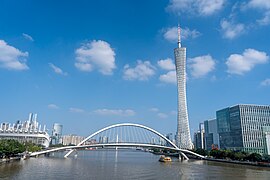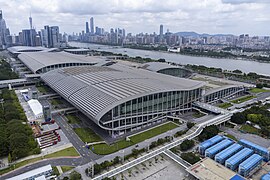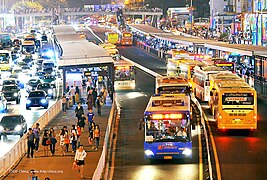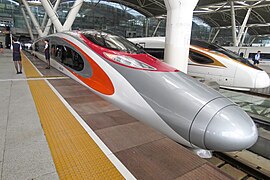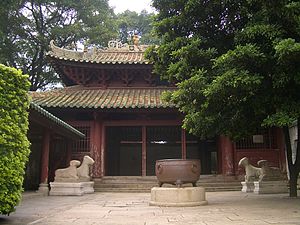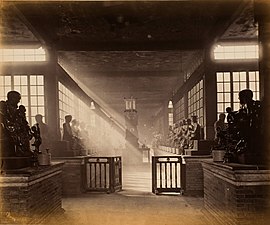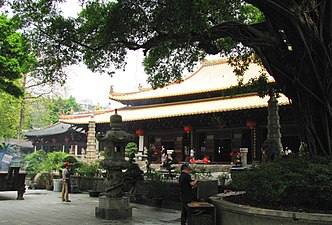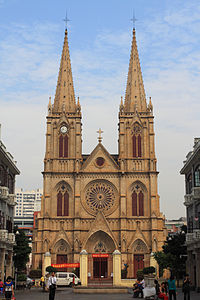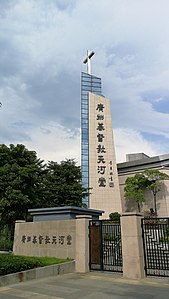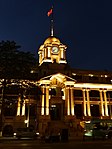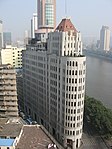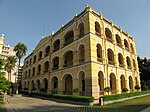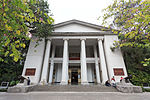Guangzhou
Guangzhou
Quảng Châu Canton; Kwangchow | |
|---|---|
| Nicknames: City of Rams, City of Flowers, City of Rice Spike | |
 | |
 Location of Guangzhou City jurisdiction in Guangdong | |
| Coordinates (Guangdong People's Government):23°07′48″N113°15′36″E/ 23.13000°N 113.26000°E | |
| Country | China |
| Province | Guangdong |
| Settled | 214 BC |
| Founded by | Qin dynasty |
| Municipal seat | Yuexiu District |
| Government | |
| • Type | Sub-provincial city |
| • Body | Guangzhou Municipal People's Congress |
| •CCP Secretary | Guo Yonghang |
| •CongressChairman | Wang Yanshi |
| •Mayor | Sun Zhiyang |
| •CPPCCChairman | Li Yiwei |
| Area | |
| •Prefecture-levelandsub-provincial city | 7,434.4 km2(2,870.4 sq mi) |
| • Urban | 2,256.4 km2(871.2 sq mi) |
| • Metro | 20,144.1 km2(7,777.7 sq mi) |
| Elevation | 21 m (69 ft) |
| Population (2020 census)[2] | |
| •Prefecture-levelandsub-provincial city | 18,676,605 |
| • Density | 2,500/km2(6,500/sq mi) |
| •Urban | 26,940,000 |
| • Urban density | 12,000/km2(31,000/sq mi) |
| •Metro | 32,623,413 |
| • Metro density | 1,600/km2(4,200/sq mi) |
| Demonym | Cantonese |
| GDP[3] | |
| •Prefecture-levelandsub-provincial city | |
| • Per capita |
|
| Time zone | UTC+08:00(China Standard Time) |
| Postal code | 510000 |
| Area code | (0)20 |
| ISO 3166 code | CN-GD-01 |
| License plateprefixes | Việt A |
| City Flower | Bombax ceiba |
| City Bird | Chinese hwamei |
| Languages | Cantonese,Standard Chinese |
| Website | gz.gov.cn |
| Guangzhou | |||||||||||||||||||||||||||||||||||||||
|---|---|---|---|---|---|---|---|---|---|---|---|---|---|---|---|---|---|---|---|---|---|---|---|---|---|---|---|---|---|---|---|---|---|---|---|---|---|---|---|
 "Guangzhou" inSimplified(top) andTraditional(bottom) Chinese characters | |||||||||||||||||||||||||||||||||||||||
| Hanyu Pinyin | |||||||||||||||||||||||||||||||||||||||
| CantoneseYale | |||||||||||||||||||||||||||||||||||||||
| Postal |
| ||||||||||||||||||||||||||||||||||||||
| Literal meaning | "BroadPrefecture" | ||||||||||||||||||||||||||||||||||||||
| |||||||||||||||||||||||||||||||||||||||
| abbreviation | |||||||||||||||||||||||||||||||||||||||
| Chinese | Tuệ | ||||||||||||||||||||||||||||||||||||||
| Hanyu Pinyin | Suì | ||||||||||||||||||||||||||||||||||||||
| CantoneseYale | Seuih | ||||||||||||||||||||||||||||||||||||||
| |||||||||||||||||||||||||||||||||||||||
Guangzhou,[a]previously romanizedasCanton[6]orKwangchow,[7]is thecapitaland largest city ofGuangdongprovinceinsouthern China.[8]Located on thePearl Riverabout 120 km (75 mi) north-northwest ofHong Kongand 145 km (90 mi) north ofMacau,Guangzhou has a history of over 2,200 years and was a major terminus of theSilk Road.[9]
Theport of Guangzhouserves as a transportation hub and Guangzhou is one of China's three largest cities.[10]For a long time it was the only Chinese port accessible to most foreign traders. Guangzhou was captured by theBritishduring theFirst Opium Warand no longer enjoyed a monopoly after the war; consequently it lost trade to other ports such as Hong Kong andShanghai,but continued to serve as a majorentrepôt.Due to a high urban population and large volumes of port traffic, Guangzhou is classified as a Large-Port Megacity, the largest type of port city in the world. Following theSecond Battle of Chuenpiin 1841, theTreaty of Nankingwas signed betweenSir Robert Peelon behalf ofQueen VictoriaandLin Zexuon behalf ofEmperor Xuanzongand has cededHong Kongto the United Kingdom on 26 January 1841 after the agreement of theConvention of Chuenpi.[11]
Guangzhou is at the heart of theGuangdong–Hong Kong–Macau Greater Bay Area,the most populous built-up metropolitan area in the world, which extends into the neighboring cities ofFoshan,Dongguan,Zhongshan,Shenzhenand part ofJiangmen,Huizhou,ZhuhaiandMacau,forming the largesturban agglomerationon Earth with approximately 70 million residents[12]and part of thePearl River Delta Economic Zone.Administratively, the city holdssubprovincialstatus[13]and is one of China's nineNational Central Cities.[14]In the late 1990s and early 2000s, nationals ofsub-Saharan Africawho had initially settled in the Middle East and Southeast Asia moved in unprecedented numbers to Guangzhou in response to the1997/98 Asian financial crisis.[15]Thedomestic migrant populationfrom other provinces of China in Guangzhou was 40% of the city's total population in 2008. Guangzhou has one of the most expensive real estate markets in China.[16]As of the 2020 census, the registered population of the city's expansive administrative area was 18,676,605 individuals (up 47 percent from the previous census in 2010), of whom 16,492,590 lived in 9 urban districts (all butConghuaandZengcheng).[2]Due to worldwide travel restrictions at the beginning of theCOVID-19 pandemic,Guangzhou Baiyun International Airport,the major airport of Guangzhou, briefly became theworld's busiest airport by passenger trafficin 2020.[17]Guangzhou is the fifth most populous city by urban resident population in China after Shanghai,Beijing,Shenzhen andChongqing.[18]
In modern commerce, Guangzhou is best known for its annualCanton Fair,the oldest and largesttrade fairin China.[19]For three consecutive years (2013–2015), Forbes ranked Guangzhou as the best commercial city in mainland China.[20]Guangzhou is highly ranked as anAlpha (global first-tier)city together with San Francisco and Stockholm.[21]It is a majorAsia-Pacificfinance hub, ranking 21st globally in the 2020Global Financial Centres Index.[22]As an important international city, Guangzhou has hosted numerous international and national sporting events, the most notable being the2010 Asian Games,the2010 Asian Para Games,and the2019 FIBA Basketball World Cup.The city hosts 65foreign representatives,making it the major city hosting the third most foreign representatives in China, after Beijing and Shanghai.[23][24]As of 2020, Guangzhou ranks 10th in the world and 5th in China—after Beijing, Shanghai, Hong Kong and Shenzhen—for the number of billionaire residents by theHurunGlobal Rich List.[25]
Guangzhou is a major Asia-Pacificresearch and developmenthub with a high level of scientific research output,ranking 8th globallyand 4th in the Asia-Pacific,[26]and is home to many ofChina's most prestigious universities,includingSun Yat-sen University,South China University of Technology,Jinan University,South China Normal University,South China Agricultural University,Guangzhou University,Southern Medical University,Guangdong University of Technology,Guangzhou Medical University,andGuangzhou University of Chinese Medicine.[27][28][29]
Toponymy
[edit]
Guǎngzhōuis the officialromanizationof the Chinese nameQuảng Châu.The name of the city is taken from the ancientGuǎng Prefectureafter it had become the prefecture's seat of government. ThecharacterQuảngorQuảngmeans 'broad' or 'expansive'.
Before acquiring its current name, the town was known as Panyu (Punyü;Phiên Ngu), a name still borne byone of Guangzhou's districtsnot far from the main city. The origin of the name is still uncertain, with 11 various explanations being offered,[30]including that it may have referred to two local mountains.[31][32]The city has also sometimes been known as Guangzhou Fu or Guangfu after its status as the capital of aprefecture.From this latter name, Guangzhou was known to medieval Persians such asAl-MasudiandIbn Khordadbeh[33]as Khanfu (خانفو).[34]Under theSouthern Han,the city was renamed Xingwang Fu (Hưng vương phủ).[35][36]
TheChinese abbreviationfor Guangzhou isTuệ,pronouncedSeoi6in Cantonese andSuìin Mandarin—although the abbreviation on car license plates, as with the rest of the province, isViệt), after its nickname "City of Rice" (Tuệ thành.The city has long borne the nicknameCity of Rams(Dương thành) orCity of the Five Rams(Năm dương thành) from the five stones at the oldTemple of the Five Immortalssaid to have been the sheep or goats ridden by theTaoistculture heroescredited with introducingrice cultivationto the area around the time of the city's foundation.[37]The former name "City of theImmortals"(Tiên thành/Năm tiên thành) came from the same story. The more recentCity of Flowers(Hoa thành) is usually taken as a simple reference to the area's fine greenery.
The English name "Canton" derived fromPortugueseCidade de Cantão,[38]a blend ofdialectalpronunciations of "Guangdong"[39][40](e.g.,CantoneseGwong2-dung1). Although it originally and chiefly applied to the walled city, it was occasionally conflated with Guangdong by some authors. It was adopted as thePostal Map Romanizationof Guangzhou, and remained the official name until itsname changeto "Guangzhou". As an adjective, it is still used in describing thepeople,language,cuisineandcultureof Guangzhou and the surrounding Liangguang region. The 19th-century name was "Kwang-chow foo".[41]
History
[edit]Prehistory
[edit]
A settlement now known as Nanwucheng was present in the area by 1100 BC.[42][43]Some traditional Chinese histories placed Nanwucheng's founding during the reign ofKing Nan of Zhou,[44][45]emperorofZhoufrom 314 to 256 BC. It was said to have consisted of little more than a stockade of bamboo and mud.[44][45]
Nanyue
[edit]Guangzhou, then known asPanyu,was founded on the eastern bank of thePearl Riverin 214 BC.[41]Ships commanded bytradespersonsarrived on the South China coast in the lateantiquity.Surviving records from theTang dynastyconfirm, that the residents of Panyu observed a range of trade missions. Records on foreign trade ships reach upon til the late 20th century.[46]
Panyu was the seat ofQin Empire'sNanhai Commandery,and served as a base for thefirst invasionof theBaiyuelands in southern China. Legendary accounts claimed that the soldiers at Panyu were so vigilant that they did not remove their armor for three years.[47]Upon thefall of the Qin,GeneralZhao Tuoestablished the kingdom ofNanyueand made Panyu its capital in 204 BC. It remained independent throughout theChu-Han Contention,although Zhao negotiated recognition of his independence in exchange for his nominal submission to theHanin 196 BC.[48]Archeological evidence shows that Panyu was an expansive commercial center: in addition to items from central China, archeologists have found remains originating fromSoutheast Asia,India, and even Africa.[49]Zhao Tuo was succeeded byZhao Moand then Zhao Yingqi. UponZhao Yingqi's death in 115 BC, his younger sonZhao Xingwas named as his successor in violation of Chineseprimogeniture.By 113 BC, hisChinesemother, the Empress Dowager Jiu (Cù) had prevailed upon him to submit Nanyue as a formal part of the Han Empire. The nativeprime ministerLü Jia (LữGia) launched a coup, killing Han ambassadors along with the king, his mother, and their supporters.[50]A successful ambush then annihilated a Han force which had been sent to arrest him.Emperor Wu of Hantook offense and launcheda massive riverine and seaborne war:six armies underLu Bodeand Yang Pu[51]took Panyu and annexed Nanyue by the end of 111 BC.[50]
Imperial China
[edit]

Incorporated into theHan dynasty,Panyu became a provincial capital. In AD 226, it became the seat of GuangPrefecture,which gave it its modern name. TheOld Book of Tangdescribed Guangzhou as an important port in southern China.[52]Direct routes connected the Middle East and China, as shown in the records of a Chinese prisoner returning home from Iraq twelve years after his capture atTalas.[53]Relations were often strained: while China was undergoing theAn Lushan Rebellion,Arab and Persian pirates[54]sacked the city on 30 October 758[55][56][57][58]and in revenge thousands of Arabs and Persians were killed by Chinese rebels in theYangzhou massacre (760).In theGuangzhou massacreabout 200,000 Arab, Persian and other foreigners were killed by Chinese rebelHuang Chaoin 878, along with the city'sJews,Christians,[59][60][61]andParsis.[62][63]The port was closed for fifty years after its destruction.[54]
Amid theFive Dynasties and Ten Kingdomsthat followed the collapse of theTang dynasty,theLater LianggovernorLiu Yanused his base at Panyu to establish a "Great Yue" or "Southern Han"empire, which lasted from 917 to 971. The region enjoyed considerable cultural and economic success in this period. From the 10th to 12th century, there are records that the large foreign communities were not exclusively men, but included"Persianfemales ".[64][65]According toOdoric of Pordenone,Guangzhou was as large as three Venices in terms of area, and rivaled all of Italy in the amount of crafts produced. He also noted the large amount of ginger available as well as large geese and snakes.[66]Guangzhou was visited by theMoroccantravelerIbn Battutaduring his journey around the world in the 14th century.[67]He detailed the process by which the Chinese constructed their large ships in the port's shipyards.[68]
Shortly after theHongwu Emperor's declaration of theMing dynasty,he reversed his earlier support offoreign tradeand imposed the first of a series ofsea bans(Cấm biển).[69]These banned private foreign trade upon penalty of death for the merchant and exile for his family and neighbors.[70]Previous maritime intendancies of Guangzhou,Quanzhou,andNingbowere closed in 1384[71]and legal trade became limited to thetribute delegationssent to or by official representatives of foreign governments.[72]
Following thePortugueseconquestof theMelaka Sultanate,Rafael Perestrellotraveled to Guangzhou as a passenger on a nativejunkin 1516.[73]His report inducedFernão Pires de Andradeto sail to the city with eight ships the next year,[73]but De Andrade's exploration[74]was understood as spying[75]and his brother Simão and others began attempting to monopolize trade,[76]enslaving Chinese women[77]and children, engaging in piracy,[78]and fortifying the island ofTamão.[79][80]Rumors even circulated that Portuguese were eating the children.[81][82]The Guangzhou administration was charged with driving them off:[78]they bested the Portuguese at theBattle of Tunmen[83]and inXicao Bay;held adiplomatic missionhostage in a failed attempt to pressure the restoration of thesultan of Malacca,[84]who had been accounteda Ming vassal;[85]and, after placing them incanguesand keeping them for most of a year, ultimately executed 23 bylingchi.[86]With the help of local pirates,[81]the "Folangji"then carried out smuggling atMacao,Lampacau,andSt John'sIsland (nowShangchuan),[77]untilLeonel de Sousalegalized their trade with bribes to Admiral Wang Bo (UôngBách) and the1554 Luso-Chinese Accord.The Portuguese undertook not to raise fortifications and to pay customs dues;[87]three years later, after providing the Chinese with assistance suppressing their former pirate allies,[88]the Portuguese were permitted to warehouse their goods atMacauinstead of Guangzhou itself.[89]

In October 1646, theLongwu Emperor's brother,Zhu Yuyuefled by sea to Guangzhou, the last stronghold of theMing empire.On December 11, he declared himself the Shaowu Emperor, borrowing his imperial regalia from local theater troupes.[91]He led a successful offense against his cousinZhu Youlangbut was deposed and executed on January 20, 1647, when the Ming turncoat Li Chengdong (LýThànhĐống) sacked the city on behalf of theQing.[92]
The Qing became somewhat more receptive to foreign trade after gaining control ofTaiwanin 1683.[93]ThePortuguesefromMacauandSpaniardsfromManilareturned, as did private Muslim,Armenian,andEnglishtraders.[94]From 1699 to 1714, theFrenchandBritish East India Companiessent a ship or two each year;[94]theAustrianOstend General India Co.arrived in 1717,[95]theDutch East India Co.in 1729,[96]theDanishAsiatic Co.in 1731, and theSwedishEast India Co.the next year.[94]These were joined by the occasionalPrussianorTrieste Companyvessel. The first independent American ship arrived in 1784, and the firstcolonial Australianone in 1788.[citation needed]By that time, Guangzhou was one of the world's greatest ports, organized under theCanton System.[97]The main exports wereteaandporcelain.[94]As a meeting place of merchants from all over the world, Guangzhou became a major contributor to the rise of the modern global economy.[98]
In the 19th century, most of the city's buildings were still only one or two stories. However, there were notable exceptions such as theFlower Pagodaof theTemple of the Six Banyan Trees,and the guard tower known as theFive-Story Pagoda.The subsequently urbanized northern hills were bare and covered with traditional graves. The brick city walls were about 6 mi (10 km) in circumference, 25 ft (8 m) high, and 20 ft (6 m) wide. Its eight main gates and two water gates all held guards during the day and were closed at night. The wall rose to incorporate a hill on its northern side and was surrounded on the other three by a moat which, along with the canals, functioned as the city's sewer, emptied daily by the river's tides. A partition wall with four gates divided the northern "old town" from the southern "new town" closer to the river; the suburb ofXiguan(Saikwan; "West Gate" ) stretched beyond and the boats of fishers, traders, andTanka( "boat people" ) almost entirely concealed the riverbank for about 4 mi (6 km). It was common for homes to have a storefront facing the street and to treat theircourtyardsas a kind of warehouse.[41]The city was part of a network of signal towers so effective that messages could be relayed toBeijing—about 1,200 mi (1,931 km) away—in less than 24 hours.[99]


The Canton System was maintained until the outbreak of theFirst Opium Warin 1839. Following a series of battles in thePearl River Delta,the Britishcaptured Cantonon March 18, 1841.[100]TheSecond Battle of Cantonwas fought two months later.[101]Following the Qing's 1842treatywithGreat Britain,Guangzhou lost its privileged trade status as more and moretreaty portswere opened to more and more countries, usually including extraterritorial enclaves. Amid the decline of Qing prestige and the chaos of theRed Turban Rebellion (1854–1856),thePuntiandHakkawageda series of clan warsfrom 1855 to 1867 in which one million people died. The foreign trade facilities were destroyed by local Chinese in theArrow War(1856–1858). The international community relocated to the outskirts and most international trade moved throughShanghai.[102][103]
The concession for theGuangdong–Hankou Railwaywas awarded to theAmerican China Development Co.in 1898. It completedits branch linewest toFoshanandSanshuibefore being engulfed in a diplomatic crisis after a Belgian consortium bought a controlling interest and the Qing subsequently canceled its concession.J.P. Morganwas awarded millions in damages[104]and the line toWuchangwas not completed until 1936[105]and the completion of a unifiedBeijing–Guangzhou Railwaywaited until the completion ofWuhan'sYangtze River Bridgein 1957.
Modern China
[edit]Revolutions
[edit]During the late Qing dynasty, Guangzhou was the site of revolutionary attempts such as theUprisings of 1895and1911that were the predecessors of the successfulXinhai Revolution,which overthrew the Qing dynasty. The 72 revolutionaries whose bodies were found after the latter uprising are honored as the city's 72Martyrsat the Huanghuagang ( "Yellow Flower Mound" ) Mausoleum.
Republic of China
[edit]After the assassination ofSong JiaorennandYuan Shikai's attempts to remove theNationalist Party of Chinafrom power, the leader of GuangdongHu Hanminjoined the 1913Second Revolutionagainst him[106]but was forced to flee toJapanwithSun Yat-senafter its failure. The city came under national spotlight again in 1917, when Prime MinisterDuan Qirui's abrogation of the constitution triggered theConstitutional Protection Movement.Sun Yat-sencame to head theGuangzhou Military Governmentsupported by the members of the dissolved parliament and the Southwestern warlords. The Guangzhou government fell apart as the warlords withdrew their support. Sun fled toShanghaiin November 1918 until the Guangdong warlordChen Jiongmingrestored him in October 1920 during theYuegui Wars.[107]On June 16, 1922, Sun was ousted in a coup and fled on the warshipYongfengafter Chen sided with theZhili Clique'sBeijing government.In the following months Sun mounted a counterattack into Guangdong by rallying supporters from Yunnan and Guangxi, and in January establisheda governmentin the city for the third time.
From 1923 to 1926 Sun and the Kuomintang (KMT)used the city as a baseto prosecute a renewed revolution in China by conquering the warlords in the north. Although Sun was previously dependent on opportunistic warlords who hosted him in the city, with the leadership of Chiang Kai-shek, the KMT developed its own military power to serve its ambition. The Canton years saw the evolution of the KMT into a revolutionary movement with a strong military focus and ideological commitment, setting the tone of the KMT rule of China beyond 1927.
In 1924, the KMT made the momentous decision to ally with the Communist Party and the USSR. With Soviet help, KMT reorganized itself along the Leninist line and adopted a pro-labor and pro-peasant stance. TheKuomintang-CCP cooperationwas confirmed in theFirst Congress of the KMTand the communists were instructed to join the KMT. The allied government set up thePeasant Movement Training Institutein the city, of which Mao Zedong was a director for one term. Sun and his military commander Chiang usedSovietfunds and weapons to build an armed force staffed by communist commissars, training its cadres in theWhampoa Military Academy.[107]In August, the fledgling army suppressed theCanton Merchants' Corps Uprising.The next year the anti-imperialistMay Thirtieth Movementswept the country, and the KMT government called for strikes in Canton and Hong Kong. The tensions of the massive strikes and protests led to theShakee Massacre.
After the death of Sun Yat-sen in 1925 the mood was changing in the party toward the communists. In August the left-wing KMT leaderLiao Zhongkaiwas assassinated and the right-wing leaderHu Hanmin,the suspected mastermind, was exiled to the Soviet Union, leaving the pro-communistWang Jingweiin charge. Opposing communist encroachment, the right-wingWestern Hills Groupvowed to expel the communists from the KMT. The "Canton Coup"on March 20, 1926, saw Chiang solidify his control over theNationalistsandtheir armyagainstWang Jingwei,the party's left wing, itsCommunistallies, and itsSovietadvisors.[108][109]By May, he had ended civilian control of the military[109]and begun hisNorthern Expeditionagainst thewarlordsof the north. Its success led to the split of the KMT between Wuhan and Nanking and the purge of the communists in theApril 12 Incident.Immediately afterwards Canton joined the purge under the auspice ofLi Jishen,resulting in the arrest of communists and the suspension of left wing KMT apparatuses and labor groups. Later in 1927 whenZhang Fakui,a general supportive of the Wuhan faction, seized Canton and installedWang Jingwei's faction in the city, the communists saw an opening and launched theGuangzhou Uprising.Prominent communist military leadersYe TingandYe Jianyingled the failed defense of the city. Soon, control of the city reverted toLi Jishen.
Li was deposed during a war between Chiang and theNew Guangxi Clique.By 1929,Chen Jitanghad established himself as the powerholder of Guangdong. In 1931 he threw his weight behind the anti-Chiang schism by hosting a separate Nationalist government in Guangzhou.[110]The opposition to Chiang included KMT leaders likeWang Jingwei,Sun Foand others from diverse factions. The peace negotiations amid the armed standoff led to the4th National Congress of Kuomintangbeing held separately by three factions in Nanjing, Shanghai and Canton. Resigning all his posts, Chiang pulled off a political compromise that reunited all factions. While the intraparty division was resolved, Chen kept his power until he was defeated by Chiang in 1936. During theWW2,the "Canton Operation"subjected the city toJapaneseoccupation by the end of December 1938.
People's Republic of China
[edit]Amid the closing months before total Communist victory, Guangzhou briefly served as the capital of the Republican government. Guangzhou was captured on October 14, 1949. Amid a massive exodus toHong KongandMacau,defeated Nationalist forces blew up theHaizhu Bridgeacross the Pearl River in retreat. The Cultural Revolution had a large effect on the city, with many of its temples, churches and other monuments destroyed during this chaotic period.
ThePeople's Republic of Chinainitiated building projects including new housing on the banks of the Pearl River to adjust the city'sboat peopleto life on land. Since the 1980s, the city's close proximity toHong KongandShenzhenand its ties tooverseas Chinesemade it one of the first beneficiaries of China'sopening upunderDeng Xiaoping.Beneficial tax reforms in the 1990s also helped the city's industrialization and economic development.
The municipality was expanded in the year 2000, withHuaduandPanyujoining the city asurban districtsandConghuaandZengchengas more ruralcounties.The former districts ofDongshanandFangcunwere abolished in 2005, merged intoYuexiuandLiwanrespectively. The city acquiredNanshaandLuogang.The former was carved out ofPanyu,the latter from parts ofBaiyun,Tianhe,Zengcheng,and an exclave withinHuangpu.TheNational People's Congressapproved a development plan for thePearl River Deltain January 2009; on March 19 of the same year, the Guangzhou andFoshanmunicipal governments agreed to establish a framework to merge the two cities.[111]In 2014,Luogangmerged intoHuangpuand bothConghuaandZengchengcounties were upgraded to districts.
On 16 June 2022 anEF2 tornado struck the city,causing major power outages and knocking out power to the city's subway lines.[112][113][114]
-
TheThirteen Factoriesc. 1805,displaying the flags ofDenmark,Spain,the United States, Sweden,Britain,and theNetherlands
-
An 1855 painting of the gallery of Tingqua, one of the most successful suppliers of "export paintings" for Guangzhou's foreign traders.
-
TheFlowery Pagodaat theTemple of the Six Banyan Treesin 1863
-
The Guangzhou Bund in 1930, with rows ofTankaboats
-
A short film of Guangzhou in 1937
-
ThePeople's Liberation Armyentering Guangzhou on 14 October 1949
Geography
[edit]
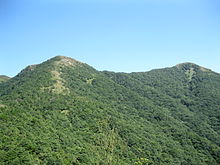
The old town of Guangzhou was nearBaiyun Mountainon the east bank of thePearl River(Zhu gian g) about 80 mi (129 km) from its junction with theSouth China Seaand about 300 mi (483 km) below itshead of navigation.[41]It commanded the rich alluvial plain of thePearl River Delta,with its connection to the sea protected at theHumen Strait.[41]The present city spans 7,434.4 km2(2,870.4 sq mi) on both sides of the river from112° 57′to114° 03′ Elongitude and22° 26′to23° 56′ Nlatitude in south-central Guangdong. The Pearl is the4th-largest riverof China.[116]Intertidal ecosystems exist on the tidal flat lining the river estuary, however, many of the tidal flats have been reclaimed for agriculture.[117]Baiyun Mountain is now locally referred to as the city's "lung" (ThịPhổi).[10][118][why?]
The elevation of the prefecture generally increases from southwest to northeast, with mountains forming the backbone of the city and the ocean comprising the front.Tiantang Peakis the highest point of elevation at 1,210 m (3,970 ft)above sea level.
Natural resources
[edit]There are 47 different types of minerals and also 820 ore fields in Guangzhou, including 18 large and medium-sized oil deposits. The major minerals are granite, cement limestone, ceramic clay, potassium, albite, salt mine, mirabilite, nepheline, syenite, fluorite, marble, mineral water, and geothermal mineral water. Since Guangzhou is located in the water-rich area of southern China, it has a wide water area with many rivers and water systems, accounting for 10% of the total land area. The rivers and streams improve the landscape and keep the ecological environment of the city stable.[119]
Water resources
[edit]The main characteristics of Guangzhou's water resources are that there are relatively few local water resources and relatively abundant transit water resources. The city's water area is 74,400 hectares, accounting for 10.05% of the city's land area. The main rivers include Bei gian g, Dong gian g North Mainstream, Zeng gian g, Liuxi River, Baini River, Pearl River Guangzhou Reach, Shiqiao Waterway, and Shawan Waterway. Bei gian g, The Dong gian g River flows through Guangzhou City and merges with the Pearl River to flow into the sea. The local average total water resources is 7.979 billion cubic meters, including 7.881 billion cubic meters of surface water and 1.487 billion cubic meters of groundwater. Calculated based on the amount of local water resources and the permanent population counted in the sixth census in 2010, there are 1.0601 million cubic meters of water resources per square kilometer, with an average of 628 cubic meters per capita, which is one-half of the country's per capita water resources. The amount of water resources for transit passengers is 186.024 billion cubic meters, which is 23 times the total local water resources. The passenger water resources are mainly concentrated in the southern Wanghe District and Zengcheng District. The passenger water resources diverted from the Xi gian g and Bei gian g Rivers into Guangzhou City are 159.15 billion cubic meters, and the passenger water resources diverted from the Dong gian g River into the north mainstream of the Dong gian g River are 14.203 billion cubic meters. meters and the water inflow from the upper reaches of the Zeng gian g River is 2.828 billion cubic meters. The southern river network area is in the tidal influence area, with large runoff and a strong tidal effect. The three major entrances of the Pearl River, Humen, Jiaomen, and Hongqili, enter the Lingding Ocean and exit the South China Sea in the south of Guangzhou City. The annual high tide volume is 271 billion cubic meters and the annual ebb tide volume is 408.8 billion cubic meters. The annual runoff of the three major entrances is 137.7 billion cubic meters. Compared with meters, the annual tide can bring a large amount of water, part of which is freshwater resources that can be utilized.[120]
Biological Resources
[edit]Cultivated crops in Guangzhou have the distinctive characteristics of the transition from the tropics to the subtropics, and it is one of the richest regions in China in terms of fruit tree resources, including three major categories of tropical, subtropical, and temperate zones, 41 families, 82 genera and 174 species, totaling more than 500 varieties (among which there are 55 major varieties of lychee). It is the center of origin and variety of lychee, longan, yellow skin, black (white) olive, and so on. Vegetables are known for their high quality and variety, with 15 major categories, 127 species, and more than 370 varieties. Flowers include fresh cut flowers (fresh cut flowers, fresh cut leaves, fresh cut branches), potted plants (potted flowers, bonsai, flower bed plants), ornamental seedlings, edible and medicinal flowers, industrial and other uses of flowers, lawns, seedlings, etc. More than 3,000 traditional varieties and in recent years the introduction of new varieties, development, and utilization. Grain, cash crops, livestock, poultry, aquatic products, wild animals, and a wide variety of famous and excellent varieties, including Zengcheng Simiao rice is the first protected variety in Guangzhou City to obtain geographical indications.[121]
Mineral Resources
[edit]The geological structure of Guangzhou City is quite complex, with good conditions for mineralization. Forty-seven kinds of minerals (including subspecies) have been discovered, with 820 mineral sites and 25 large and medium-sized mining areas. The main minerals are granite for construction, limestone for cement, ceramic clay, potassium, sodium feldspar, salt mines, manganese, nepheline orthoclase, fluorite, marble, mineral water, and thermal mineral water. Energy minerals and non-ferrous minerals in the area are in short supply, sporadically distributed, small in scale, and unstable in grade.[121] ,
Climate
[edit]Despite being located just south of theTropic of Cancer,Guangzhou has ahumid subtropical climate(KöppenCwa) influenced by theEast Asian monsoon.Summers are wet with high temperatures, high humidity, and a highheat index.Winters are mild and comparatively dry. Guangzhou has a lengthymonsoonseason, spanning from April through September. Monthly averages range from 13.8 °C (56.8 °F) in January to 28.9 °C (84.0 °F) in July, while the annual mean is 22.4 °C (72.3 °F).[10]Autumn, from October to December, is very moderate, cool and windy, and is the best travel time.[122]Therelative humidityis approximately 76 percent, whereasannual rainfallin the metropolitan area is over 1,950 mm (77 in).[10]With monthly percent possible sunshine ranging from 17 percent in March to 51 percent in October, the city receives 1,559 hours of bright sunshine annually, considerably less than nearbyShenzhenandHong Kong.Extreme temperatures have ranged from 0 °C (32 °F) to 39.4 °C (102.9 °F).[123]The last recorded snowfall in the city was on January 24, 2016, 87 years after the second last recorded snowfall.[124]
| Climate data for Guangzhou (1991–2020 normals, extremes 1951–2010) | |||||||||||||
|---|---|---|---|---|---|---|---|---|---|---|---|---|---|
| Month | Jan | Feb | Mar | Apr | May | Jun | Jul | Aug | Sep | Oct | Nov | Dec | Year |
| Record high °C (°F) | 28.4 (83.1) |
29.4 (84.9) |
32.1 (89.8) |
33.3 (91.9) |
39.4 (102.9) |
38.9 (102.0) |
39.1 (102.4) |
38.3 (100.9) |
37.6 (99.7) |
36.2 (97.2) |
33.4 (92.1) |
29.6 (85.3) |
39.4 (102.9) |
| Mean daily maximum °C (°F) | 18.7 (65.7) |
20.0 (68.0) |
22.3 (72.1) |
26.4 (79.5) |
30.0 (86.0) |
32.0 (89.6) |
33.3 (91.9) |
33.2 (91.8) |
32.0 (89.6) |
29.3 (84.7) |
25.3 (77.5) |
20.7 (69.3) |
26.9 (80.5) |
| Daily mean °C (°F) | 13.8 (56.8) |
15.5 (59.9) |
18.3 (64.9) |
22.5 (72.5) |
26.0 (78.8) |
27.9 (82.2) |
28.9 (84.0) |
28.6 (83.5) |
27.4 (81.3) |
24.4 (75.9) |
20.2 (68.4) |
15.4 (59.7) |
22.4 (72.3) |
| Mean daily minimum °C (°F) | 10.6 (51.1) |
12.5 (54.5) |
15.5 (59.9) |
19.6 (67.3) |
23.1 (73.6) |
25.1 (77.2) |
25.8 (78.4) |
25.5 (77.9) |
24.2 (75.6) |
20.9 (69.6) |
16.7 (62.1) |
11.9 (53.4) |
19.3 (66.7) |
| Record low °C (°F) | 0.1 (32.2) |
1.3 (34.3) |
3.2 (37.8) |
7.7 (45.9) |
13.7 (56.7) |
18.8 (65.8) |
21.6 (70.9) |
20.9 (69.6) |
15.5 (59.9) |
9.5 (49.1) |
4.9 (40.8) |
0.0 (32.0) |
0.0 (32.0) |
| Averageprecipitationmm (inches) | 51.1 (2.01) |
56.1 (2.21) |
101.0 (3.98) |
193.8 (7.63) |
329.0 (12.95) |
364.9 (14.37) |
242.6 (9.55) |
270.3 (10.64) |
203.2 (8.00) |
67.3 (2.65) |
37.4 (1.47) |
33.4 (1.31) |
1,950.1 (76.77) |
| Average precipitation days(≥ 0.1 mm) | 7.2 | 9.4 | 13.8 | 15.3 | 17.4 | 19.4 | 17.0 | 16.8 | 12.0 | 5.7 | 5.7 | 5.7 | 145.4 |
| Averagerelative humidity(%) | 72 | 76 | 80 | 82 | 81 | 82 | 79 | 80 | 77 | 70 | 69 | 67 | 76 |
| Mean monthlysunshine hours | 112.9 | 77.5 | 61.6 | 69.1 | 103.4 | 127.5 | 179.0 | 166.4 | 167.0 | 182.2 | 159.7 | 152.7 | 1,559 |
| Percentpossible sunshine | 33 | 24 | 17 | 18 | 25 | 32 | 43 | 42 | 46 | 51 | 49 | 46 | 36 |
| Source: China Meteorological Data Service Center[125][126][127]all-time extreme temperature[123] | |||||||||||||
Administrative divisions
[edit]Guangzhou is asub-provincial city.It has direct jurisdiction over elevendistricts:
| |||||||||||||||||||||||||||||||||||||||||||||||||||||||||||||||||||||||||||||||||||||||||||||||||||||||||||||||||||||||||||||||||||||||||||||||||
| |||||||||||||||||||||||||||||||||||||||||||||||||||||||||||||||||||||||||||||||||||||||||||||||||||||||||||||||||||||||||||||||||||||||||||||||||
Economy
[edit]Guangzhou is the main manufacturing hub of thePearl River Delta,one ofmainland China's leading commercial and manufacturing regions. In 2021, its GDP reached ¥2,823 billion (US$444.37 billion in nominal), making it the 2nd largest economy in theSouth-Central Chinaregion afterShenzhen.[132]Guangzhou'sGDP (nominal)was $444.37 billion in 2021, exceeding that[133]Guangzhou's per capita was ¥151,162 ($23,794 in nominal).[132]Guangzhou is considered one of the most prosperous cities in China. Guangzhou ranks 10th in the world and 5th in China (after Beijing, Shanghai, Hong Kong and Shenzhen) in terms of the number of billionaires according to the Hurun Global Rich List 2020.[25]Guangzhou is projected to be among the world top 10 largest cities in terms ofnominal GDPin 2035 (together withShanghai,BeijingandShenzhenin China) according to a study by Oxford Economics,[134]and its nominal GDP per capita will reach above $42,000 in 2030.[135]Guangzhou also ranks 21st globally (between Washington, D.C., and Amsterdam) and 8th in the wholeAsia&Oceaniaregion (behind Shanghai, Tokyo, Hong Kong, Singapore, Beijing, Shenzhen and Dubai) in the 2020Global Financial Centers Index(GFCI).[22]Owing to rapid industrialization, it was once also considered a rather polluted city. After green urban planning was implemented, it is now one of the most livable cities in China.
Zhu gian g New Town
[edit]Zhu gian g New Townis thecentral business districtof Guangzhou in the 21st century. It covers 6.44 km2inTianhe District.Multiple financial institutions are headquartered in this area.
-
Zhu gian g New Town
-
Skyscrapers in Zhu gian g New Town
-
Skyscrapers in Zhu gian g New Town
-
Haixin Bridge andCanton Towernear Zhu gian g New Town
-
Zhu gian g New Town at night
Canton Fair
[edit]TheCanton Fair,formally the "China Import and Export Fair", is held every year in April and October by theMinistry of Trade.Inaugurated in the spring of 1957, the fair is a major event for the city. It is thetrade fairwith the longest history, highest level, and largest scale in China.[136]From the 104th session onwards, the fair moved to the newGuangzhou International Convention and Exhibition Center(Quảng ChâuQuốc tếSẽ triểnTrung tâm) inPazhou,from the older complex in Liuhua. The GICEC is served by two stations onLine 8and three stations onTram Line THZ1.Since the 104th session, the Canton Fair has been arranged in three phases instead of two phases.
-
The former Canton Fair site atYuexiu's Liuhua Complex
-
The newCanton Fair Complex
-
Interior of theCanton Fair Complex
Local products
[edit]This sectionneeds additional citations forverification.(June 2016) |
- Cantonese cuisineis one of China's most famous and popularregional cuisines,with asayingstating simply to "Eat in Guangzhou" (ThựcỞQuảng Châu).
- Cantonesesculptureincludes work injade,wood,and (controversially)ivory.
- Canton porcelaindeveloped over the past three centuries as one of the major forms ofexportware.It is now known within China for its highly colorful style.
- Cantoneseembroideryis one ofchina's four main stylesof the embroidery.
- Zhu gian g Beer,apale lager,is one of China's most successful brands.
Industry
[edit]
- GAC Group
- Guangzhou Economic and Technological Development Zone
- Guangzhou Nansha Export Processing Zone
- The Export Processing Zone was founded in 2005. Its total planned area is 1.36 km2(0.53 sq mi).[137]It is located in Nansha District and it belongs to the provincial capital, Guangzhou. The major industries encouraged in the zone include automobile assembly, biotechnology and heavy industry. It is situated 54 km (34 mi) (a 70 minutes drive) south of Guangzhou Baiyun International Airport and close to Nansha Port. It also has the advantage of Guangzhou Metro line 4 which is being extended to Nansha Ferry Terminal.
- Guangzhou Free Trade Zone
- The zone was founded in 1992. It is located in the east ofHuangpu Districtand near to Guangzhou Economic and Technological Development Zone. It is also very close to Guangzhou Baiyun Airport.[138]The major industries encouraged in the zone include international trade, logistics, processing and computer software. Recently the Area has been rebranded and is now being marketed under the name Huangpu District. Next to the industries above, new sectors are being introduced to the business environment, including new energy, AI, new mobility, new materials, information and communication technology and new transport. It is also home to the Guangzhou IP Court.[139]
- Guangzhou Science City
Business Environment
[edit]Guangzhou is a hub for international businesses. According to an article by China Briefing, over 30,000 foreign-invested companies had settled in Guangzhou by 2018, including 297 Fortune Global 500 companies with projects and 120 Fortune Global 500 companies with headquarters or regional headquarters in the city.[140]
Demographics
[edit]| Year | Pop. | ±% |
|---|---|---|
| 1950[141] | 2,567,645 | — |
| 1960[141] | 3,683,104 | +43.4% |
| 1970[141] | 4,185,363 | +13.6% |
| 1980[141] | 5,018,638 | +19.9% |
| 1990[141] | 5,942,534 | +18.4% |
| 2000[141] | 9,943,000 | +67.3% |
| 2002[142] | 10,106,229 | +1.6% |
| 2005[143] | 9,496,800 | −6.0% |
| 2006[143] | 9,966,600 | +4.9% |
| 2007[143] | 10,530,100 | +5.7% |
| 2008[143] | 11,153,400 | +5.9% |
| 2009[143] | 11,869,700 | +6.4% |
| 2010[141] | 12,701,948 | +7.0% |
| 2011[144] | 12,751,400 | +0.4% |
| 2012[144] | 12,832,900 | +0.6% |
| 2013[144] | 12,926,800 | +0.7% |
| 2014[144] | 13,080,500 | +1.2% |
| 2018 | 14,904,400 | +13.9% |
| Population size may be affected by changes to administrative divisions. | ||
The2010 censusfound Guangzhou's population to be 12.78 million. As of 2014[update],it was estimated at 13,080,500,[145][144]with 11,264,800 urban residents.[146]Itspopulation densityis thus around 1,800 people per km2.The built-up area of the Guangzhou proper connects directly to several other cities. The built-up area of thePearl River Delta Economic Zonecovers around 17,573 km2(6,785 sq mi) and has been estimated to house 22 million people, including Guangzhou's nine urban districts,Shenzhen(5.36m),Dongguan(3.22m),Zhongshan(3.12m), most ofFoshan(2.2m),Jiangmen(1.82m),Zhuhai(890k), andHuizhou'sHuiyang District(760k).[citation needed]The total population of this agglomeration is over 28 million after including the population of the adjacentHong Kong Special Administrative Region.[citation needed]The area's fast-growing economy and high demand for labor has produced a huge "floating population" ofmigrant workers;thus, up to 10 million migrants reside in the area least six months each year.[citation needed]In 2008, about five million of Guangzhou's permanent residents werehukoulessmigrants.[147]
Ethnicity and language
[edit]Most of Guangzhou's population isHan Chinese.Almost allCantonese peoplespeakCantoneseas their first language,[149]while most migrants speakforms of Mandarin.[147]In 2010, each language was the native tongue of roughly half of the city's population,[150]although minor but substantial numbers speakother varietiesas well.[citation needed]In 2018, He Huifeng of theSouth China Morning Poststated that younger residents have increasingly favored using Mandarin instead of Cantonese in their daily lives, causing their Cantonese-speaking grandparents and parents to use Mandarin to communicate with them. He Huifeng stated that factors included local authorities discouraging the use of Cantonese in schools and the rise in prestige of Mandarin-speaking Shenzhen.[151]Jinan University released a survey result of the Guangzhou youths born in the year 2000 or after that were part of this educational study showed that 69% could still speak and understand Cantonese, 20% can understand Cantonese, but unable to speak it, and 11% completely had no knowledge of Cantonese. Jinan University's study of these Guangzhou youths also indicated when it came to the daily recreational use of Cantonese, roughly 40%-50% of them participated in these recreational functions with the usage of Cantonese with 51.4% of them in mobile games, 47% in Social Platforms, 44.1% in TV shows, and 39.8% in Books and Newspapers. Despite some decline in the use of Cantonese, it is faring better in survival, popularity, and prestige than other Chinese languages due to the historical pride in the language and culture, as well as the wide popularity and availability of mainstream Cantonese entertainment, which encourages locals to retain the Cantonese language.[152][153]As of the 2020s, additional renewed efforts were introduced to preserve the local Cantonese language and culture with some limited Cantonese language classes now being taught in some schools as well as hosting Cantonese appreciation cultural events along with hosting activities that cater to the local Cantonese culture and language as well as many local Cantonese speaking families are now placing much stronger emphasis on their children to speak Cantonese to preserve the culture and language. In a 2018 report study by Shan Yunming and Li Sheng, the report showed that 90% of people living in Guangzhou are bilingual in both Cantonese and Mandarin, though fluency will vary depending on if they are locally born to the city and the surrounding Guangdong province or migrants from other provinces, which shows how much importance the Cantonese language still has in the city despite the strict policy rules from the government to be using Mandarin as the country's official language.[154][155]Guangzhou has an even more unbalanced gender ratio than the rest of the country. While most areas of China have 112–120 boys per 100 girls, the Guangdong province that houses Guangzhou has more than 130 boys for every 100 girls.[156][157][158]
Guangzhou also possesses a large resident population who areHakka people.There are seven administrative districts in Guangzhou with a considerableHakkapopulation:Zengcheng District,Huadu District,Conghua District,Baiyun District,Tianhe District,Yuexiu DistrictandPanyu District.It is estimated that in Zengcheng district and Huadu district of Guangzhou, Hakka speakers account for about 40 percent and a third of the district's population.[159][160]
Recent years have seen a huge influx of migrants, with up to 30 million additional migrants living in the Guangzhou area for at least six months out of every year with the majority being female migrants and many becoming local Guangzhou people. This huge influx of people from other areas, called the floating population, is due to the city's fast-growing economy and high labor demands. Guangzhou Mayor Wan Qingliang told an urban planning seminar that Guangzhou is facing a very serious population problem stating that, while the city had 10.33 million registered residents at the time with targets and scales of land use based on this number, the city actually had a population with migrants of nearly 15 million. According to the Guangzhou Academy of Social Sciences researcher Peng Peng, the city is almost at its maximum capacity of just 15 million, which means the city is facing a great strain, mostly due to a high population of unregistered people.[156]
According to the 2000 National Census, marriage is one of the top two reasons for permanent migration and is particularly important for women as 29.3% of the permanent female migrants migrate for marriage [Liang et al.,2004]. Many of the female economic migrants marry men from Guangzhou in hopes of a better life.[161]but like elsewhere in thePeople's Republic of China,thehousehold registration system(hukou) limits migrants' access to residences, educational institutions and other public benefits. It has been noted that many women end up in prostitution.[162]In May 2014, legally employed migrants in Guangzhou were permitted to receive ahukoucard allowing them to marry andobtain permission for their pregnanciesin the city, rather than having to return to their official hometowns as previously.[163]
Historically, the Cantonese people have made up a sizable part of the 19th- and 20th-centuryChinese diaspora;in fact, manyoverseas Chinesehave ties to Guangzhou. This is particularly true in theUnited States,[164]Canada,[165]andAustralia.
Demographically, the only significant immigration into China has been byoverseas Chinese,but Guangzhou sees many foreign tourists, workers, and residents from theusual locationssuch as theUnited States.Notably, it is also home to thousands ofAfrican immigrants,including people fromNigeria,Somalia,Angolaand theDemocratic Republic of Congo.[166]
Metropolitan area
[edit]The encompassingmetropolitan areawas estimated by theOECD(Organization for Economic Cooperation and Development) to have, as of 2010[update],a population of 25 million.[167][168]
Development of Guangzhou
[edit]Gong et al 2018 report on the development of Guangzhou from 1990 until 2020, showing how in 1990, the developed residential districts were almost exclusively concentrated in a small part of western Guangzhou whereas other parts of Guangzhou had a smaller limited amount of developed residential communities being overwhelmingly surrounded by agricultural and forest lands. However, from 2005 until 2020, other parts of the city eventually began to develop more so residential communities and in the 2020 map report, it showed fully developed residential communities going from west to east of the city whereas the very southern part and large portions of northern Guangzhou still remain mainly agricultural and forest lands with very limited developed residential communities.[169][170]
Transportation
[edit]Urban mass transit
[edit]
When the first line of theGuangzhou Metroopened in 1997, Guangzhou was the fourth city inMainland Chinato have an underground railway system, behindBeijing,Tianjin,andShanghai.Currently the metro network is made up of sixteen lines, covering a total length of 652.81 km (405.64 mi).[171]A long-term plan is to make the city's metro system expand to over 500 km (310 mi) by 2020 with 15 lines in operation. In addition to the metro system there is also theHaizhu Tramline which opened on December 31, 2014.[172]
TheGuangzhou Bus Rapid Transit(GBRT) system which was introduced in 2010 alongZhongshan Road.It has several connections to the metro and is the world's 2nd-largestbus rapid transitsystem with 1,000,000 passenger trips daily.[173]It handles 26,900pphpdduring the peak hour a capacity second only to theTransMilenioBRT system in Bogota.[174]The system averages one bus every 10 seconds or 350 per hour in a single direction and contains the world's longest BRT stations—around 260 m (850 ft) including bridges.
Motor transport
[edit]
In the 19th century, the city already had over 600 long, straight streets; these were mostly paved but still very narrow.[41]In June 1919, work began on demolishing the city wall to make way for wider streets and the development of tramways. The demolition took three years in total.[175]
In 2009, it was reported that all 9,424 buses and 17,695 taxis in Guangzhou would be operating onLPG-fuel by 2010 to promote clean energy for transport and improve the environment ahead of the2010 Asian Gameswhich were held in the city.[176]At present[when?],Guangzhou is the city that uses the most LPG-fueled vehicles in the world, and at the end of 2006, 6,500 buses and 16,000 taxis were using LPG, taking up 85 percent of all buses and taxis.[citation needed]

Effective January 1, 2007, the municipal government banned motorcycles in Guangdong's urban areas. Motorcycles found violating the ban are confiscated.[177]The Guangzhou traffic bureau claimed to have reported reduced traffic problems and accidents in the downtown area since the ban.[178]
Airports
[edit]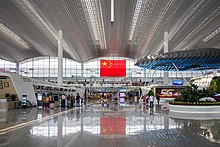
Guangzhou's main airport is theBaiyun International AirportinBaiyun District;it opened on August 5, 2004.[179]This airport is the second busiest airport in terms of traffic movements in China. It replaced theold Baiyun International Airport,which was very close to the city center but failed to meet the city's rapidly growing air traffic demand. The old Baiyun International Airport was in operation for 72 years. Guangzhou Baiyun International Airport now has three runways, with two more planned.[180]Terminal 2 opened on April 26, 2018.[181]Another airport located in Zengcheng District is under planning.[182]
Guangzhou is served byHong Kong International Airport;ticketed passengers can take ferries from the Lianhuashan Ferry Terminal andNansha Ferry PortinNansha Districtto the HKIASkypier.[183]There are also coach bus services connecting Guangzhou with HKIA.[184]
Rail
[edit]Guangzhou is the terminus of theBeijing–Guangzhou,Guangzhou–Shenzhen,Guangzhou–MaomingandGuangzhou–Meizhou–Shantouconventional speed railways. In late 2009, theWuhan–Guangzhou high-speed railwaystarted service, withmultiple unittrains covering 980 km (608.94 mi) at a top speed of 320 km/h (199 mph). In December 2014, theGuiyang–Guangzhou high-speed railwayand Nanning-Guangzhou railway began service with trains running at top speeds of 250 km/h (155 mph) and 200 km/h (124 mph), respectively.[185]TheGuangdong Through Traindeparts from theGuangzhou East railway stationand arrives at theHung Hom stationinKowloon,Hong Kong. The route is approximately 182 km (113 mi) in length and the ride takes less than two hours. Frequent coach services are also provided with coaches departing every day from different locations (mostly major hotels) around the city. A number ofregional railwaysradiating from Guangzhou started operating such as theGuangzhou–Zhuhai intercity railwayand theGuangzhou-Foshan-Zhaoqing intercity railway.
Water transport
[edit]There are daily high-speedcatamaranservices between Nansha Ferry Terminal and Lianhua Shan Ferry Terminal in Guangzhou and theHong Kong China Ferry Terminal,as well as between Nansha Ferry Terminal andMacau Ferry Pierin Hong Kong.
- Transport in Guangzhou
-
Trains used by theGuangzhou Metro
-
GBRTstation
Culture
[edit]
Guangzhou's culture is mainlyCantonese culture,which is a subset of the larger "Southern"or the"Lingnan"culture, followed byHakka culture.[186]Notable aspects ofCantonese culturalheritage include:
- Cantonese language,the local andprestige variantofYue Chinese.
- Cantonese cuisine,one of China's eight major culinary traditions.[187][note 1]
- Cantonese opera,usually divided into martial and literary performances.
- Xiguan(Saikwan), the area west of the former walled city.
TheGuangzhou Opera House&Symphony Orchestraalso perform classical Western music and Chinese compositions in their style.Cantonese musicis a traditional style of Chinese instrumental music, whileCantopopis the local form ofpop musicandrock-and-rollwhich developed from neighboringHong Kong.
It is worth noting thatCantonese language,Cantonese cuisineandCantonese operaare the shared culture of the wholeGuangdongregion, not just the important cultural components of Guangzhou city. With a population of diverse background, the culture of Guangzhou also includes other categories, such asHakkaculture and language.
In theHakka peopleinhabited areas of Guangzhou, Hakka culture has been well developed and preserved, and in the long history, the integration of Canton culture and Hakka culture has derived new cultural characteristics.Zengcheng, Guangzhouis a district with a history of more than 1800 years, with the harmonious coexistence of Canton culture and Hakka culture, the derived food culture has not only the non-heritage food such as Zhengguo Wonton, Lanxi Rice Noodle, and Goose Soup, but also the special food such as Yuecun Dace Fish Skin, Paitan Roasted Chicken, and Shitan Whole Cattle Banquet.[189]
Religions
[edit]Before the postmodern era, Guangzhou had about 124 religious pavilions, halls, and temples.[41]Today, in addition to theBuddhist Association,Guangzhou also has aTaoist Association,a Jewish community,[190][191]as well as a history with Christianity, reintroduced to China by colonial powers.[clarification needed]
Taoism
[edit]TaoismandChinese folk religionare still represented at a few of the city's temples. Among the most important is theTemple of the Five Immortals,dedicated to theFive Immortalscredited with introducing rice cultivation at the foundation of the city. The five rams they rode were supposed to have turned into stones upon their departure and gave the city several of its nicknames.[192]However, the temple has not been restored as a Taoist temple status yet. Other famous temples include theCity God Temple of GuangzhouandSanyuan Palace.During theCultural Revolution,all Taoist temples and shrines were practically destroyed or damaged by the red guards. Only a handful of them like Sanyuan Palace were restored during the 1980s. Guangzhou, like most of southern China, is also notably observant and continues the practice ofChinese ancestral worshipduring major festive occasions like theQing Ming FestivalandZhong Yuan Festival.
Buddhism
[edit]Buddhismis the most prominent religion in Guangzhou.[193]The Zhizhi Temple was founded in AD 233 from the estate of aWuofficial; it is said to comprise the residence ofZhao Jiande,the last of theNanyuekings,and has been known as theGuangxiao Temple( "Temple of Bright Filial Piety" ) since theMing dynasty.TheBuddhist missionary monk,Bodhidharmais traditionally said to have visited Panyu during theLiu SongorLiang dynasty(5th or 6th century). Around AD 520,Emperor Wuof theLiangordered the construction of the Baozhuangyan Temple and the Xilai Monastery to store the relics ofCambodianBuddhist saintswhich had been brought to the city and to house the monks beginning to assemble there. The Baozhuangyan is now known as theTemple of the Six Banyan Trees,after a famous poem composed bySu Shiafter a visit during theNorthern Song.[citation needed]The Xilai Monastery was renamed as theHualin Temple( "Flowery Forest Temple" ) after its reconstruction during theQing dynasty.
The temples were badly damaged by both theRepublicancampaign to "Promote Education with Temple Property" (MiếuSảnHưngHọc) and thePRC's Cultural Revolution but have been renovated since theopening upthat began in the 1980s. The Ocean Banner Temple onHenan Island,once famous in the west as the only tourist spot in Guangzhou accessible to foreigners, has been reopened as theHoi Tong Monastery.
Christianity
[edit]NestorianChristiansfirst arrived in Chinavia the overlandSilk Road,but suffered duringEmperor Wuzong's 845persecutionand were essentially extinct by the year 1000.[194][specify]TheQing-era ban on foreigners limitedmissionariesuntil itwas abolishedfollowing theFirst Opium War,although theProtestantRobert Morrisonwas able to perform some work through his service with the British factory. TheRoman Catholic Archdiocese of Guangzhouis housed atGuangzhou's Sacred Heart Cathedral,known locally as the "Stone House". AGothic Revivaledifice which was built by hand from 1861 to 1888 underFrenchdirection, its original Latin and Frenchstained-glass windowswere destroyed during the wars and amid the Cultural Revolution; they have since been replaced by English ones. The Canton Christian College (1888) and Hackett Medical College for Women (1902) were both founded by missionaries, they were known in chinese asLingnan Universityand later incorporated intoSun Yat-sen University.Since the opening up of China in the 1980s, there has been renewed interest in Christianity, but Guangzhou maintains pressure on underground churches which avoid registration with government officials.[195]The Catholic archbishopDominic Tangwas imprisoned without trial for 22 years; however, his present successor is recognized by both theVaticanand China'sPatriotic Church.
Islam
[edit]Guangzhou has had ties with the Islamic world since theTang dynasty.[196]Relations were often strained: Arab and Persian pirates sacked the city on October 30, 758; the port was subsequently closed for fifty years.[54][55][56][57][58]Their presencecame to an endunder the revenge of Chinese rebelHuang Chaoin 878, along with that of theJews,Christians,[59][60][61]andParsis.[62][63]Nowadays, the city is home tohalal restaurants.[197]
- Religious sites in Guangzhou
-
The Hall of the 500 Arhatsat theFlowery Forest Temple(Hualin) in the 1870s
-
Guangzhou'sCity God Temple
-
The sacred pigs of theOcean Banner Temple(Hoi Tong)in the 1830s
-
TheFlower Pagodaat theTemple of the Six Banyan Trees(Liurong)
-
The Thousand Buddha Tower at the present-dayHoi Tong Monastery
-
Tianhe Church,built in 2017
Sports
[edit]
The 11,468 seatGuangzhou Gymnasiumwas a2019 FIBA Basketball World Cupvenue.[198]
From November 12 to 27, 2010, Guangzhou hosted the16th Asian Games.The same year, it hosted thefirst Asian Para Gamesfrom December 12 to 19. Combined, these were the major sporting events the city ever hosted.[199]

Guangzhou also hosted the following major sporting events:
- 1987 The 6thNational Games of China
- 1991 The1st FIFA Women's World Cup
- 2001 The2001 National Games of China
- 2007 The 8thNational Traditional Games of Ethnic Minorities of the People's Republic of China
- 2008 The49th World Table Tennis Championships
- 2009 The11th Sudirman Cup:the world badminton mixed team championships
Current professional sports clubs based in Guangzhou include:

In the 2010s,Guangzhoubecame a Chinese soccer powerhouse, having won eightnational titlesbetween 2011 and 2019. The team has also won theAFC Champions Leaguein2013and2015.The club has competed at the2013and2015 FIFA Club World Cup,where it lost 3–0 in the semifinal stage to the2012–13 UEFA Champions LeaguewinnersFC Bayern Munichand the2014–15 UEFA Champions LeaguewinnersFC Barcelona,respectively.[200]
Restaurants
[edit]In the 1990s the local press prolifically published reviews of restaurants in Guangzhou. The local newspapers introducedlifestylepages and relied oninfotainmentto encourage the purchase of adaily newspaper.[201][page needed]
Destinations
[edit]Eight Views
[edit]
TheEight Views of Ram Cityare Guangzhou's eight most famous tourist attractions. They have varied over time since theSong dynasty,with some being named or demoted by emperors. The following modern list was chosen through public appraisal in 2011:[citation needed]
- "Towers Shining through theNew Town"
- "The Pearl River Flowing and Shining": ThePearl RiverfromBai'etantoPazhou
- "Cloudy Mountain Green and Tidy":Baiyun Mountain Scenic Area
- "Yuexiu's Grandeur":Yuexiu HillandPark
- "The Ancient Academy's Lingering Fame": TheChen Clan Ancestral Halland its folk art museum
- "Liwan's Wonderful Scenery":Liwan Lake
- "Science City,Splendid as Brocade "
- "Wetlands Singing at Night":Nansha Wetlands Park

Parks and gardens
[edit]- Baiyun Mountain
- Nansha Wetland Park
- People's Park
- South China Botanical Garden
- Yuexiu Park
- Guangdong Tree Park
- Dongshanhu Park (Đông Sơn hồ công viên;Đông Sơn hồ công viên)
- Liuhuahu Park (Lưu hoa hồ công viên;Lưu hoa hồ công viên)
- Liwanhu Park (Lệ loan hồ công viên;Lệ loan hồ công viên)
- Luhu Park (Lộc hồ công viên;Lộc hồ công viên)
- Martyrs' Park (Cuộc khởi nghĩa Quảng Châu liệt sĩ nghĩa trang;Cuộc khởi nghĩa Quảng Châu liệt sĩ nghĩa trang)
- Pearl River Park (Châu Giang công viên;Châu Giang công viên)
- Yuntai Garden (Vân đài hoa viên;Vân đài hoa viên)
- Shimen National Forest Park(Cửa đá quốc gia rừng rậm công viên;Cửa đá quốc gia rừng rậm công viên)
- Haizhu Lake Park(Hải châu hồ công viên;Hải châu hồ công viên)
Tourist attractions
[edit]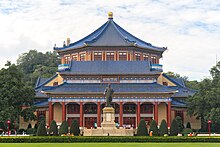
Guangzhou attracts more than 223 million visitors each year, and the total revenue of the tourism exceeded 400 billion in 2018.[203]There are many tourist attractions, including:
- Canton Tower
- Chen Clan Ancestral Hall,housing Guangzhou's folk art museum
- Chime-Long Paradise
- Chime-Long Waterpark (simplified Chinese:Trường long thủy thượng nhạc viên;traditional Chinese:Trường long thủy thượng nhạc viên)
- Guangdong Provincial Museum
- Guangzhou Zoo
- Mulberry Park,public center which demonstrates mulberry growing and silk making
- Museum of the Mausoleum of the Nanyue King
- Peasant Movement Training Institute,an important Maoist site
- Sacred Heart Cathedral(Stone House)
- Temple of Bright Filial Piety(Guangxiao)
- Temple of the Six Banyan Trees(Liurong), site of the Flowery Pagoda
- Sanyuan Palace
- Shamianor Shameen Island, the old trading compound
- Sun Yat-sen Memorial Hall,site of Guangzhou's former presidential palace
- Xiguan(Saikwan), the western suburbs of the old city
Pedestrian streets
[edit]In every district there are many shopping areas where people can walk on the sidewalks; however most of them are not set as pedestrian streets.

The popular pedestrian streets are:
- Beijing Road pedestrian street
- Shangxiajiu Pedestrian Street
- Huacheng Square(Flower City Square)
Malls and shopping centers
[edit]There are many malls and shopping centers in Guangzhou. The majority of the new malls are located in the Tianhe district.

- 101 Dynamics
- China Plaza
- Liwan Plaza
- Teem Plaza
- Victory Plaza
- Wanguo Plaza
- Grandview Mall (Grandview Mall Aquarium)
- Wanda square
- Happy Valley
- TaiKoo Hui
- Parc Central
- OneLinkWalk
- Rock Square
- Aeon Mall
- GT Land Plaza
- IFC Plaza
- IGC Mall
- Mall of the World
- K11
- Fashion Tianhe
Major buildings
[edit]-
Canton Custom House(est. 1916),one of the oldest surviving in China
-
Aiqun Hotel,Guangzhou's tallest building from 1937 to 1967
-
Our Lady of Lourdes Chapel onShamian
-
The Canton Cement Factory(est. 1907),which housedSun Yat-senfrom 1923 to 1925
-
The old provincial capitol, now theMuseum of Revolutionary History
Media
[edit]This sectionneeds additional citations forverification.(September 2024) |
Guangzhou has two local radio stations: the provincialRadio Guangdongand the municipal Radio Guangzhou. Together they broadcast in more than a dozen channels. The primary language of both stations isCantonese.Traditionally only one channel of Radio Guangdong is dedicated toMandarin Chinese.However, in recent years there has been an increase in Mandarin programs on most Cantonese channels. Radio stations from cities around Guangzhou mainly broadcast in Cantonese and can be received in different parts of the city, depending on the radio stations' locations and transmission power. The Beijing-basedChina National Radioalso broadcasts Mandarin programs in the city. Radio Guangdong has a 30-minute weekly English programs,Guangdong Today,which is broadcast globally through theWorld Radio Network.Daily English news programs are also broadcast by Radio Guangdong.
Guangzhou has some of the most notable Chinese-language newspapers and magazines inmainland China,most of which are published by three major newspaper groups in the city, theGuangzhou DailyPress Group,Nanfang Press Corporation,and theYangcheng Evening NewsGroup. The two leading newspapers of the city areGuangzhou DailyandSouthern Metropolis Daily.The former, with a circulation of 1.8 million, has been China's most successful newspaper for 14 years in terms of advertising revenue, whileSouthern Metropolis Dailyis considered one of the most liberal newspapers in mainland China. In addition to Guangzhou's Chinese-language publications, there are a few English magazines and newspapers. The most successful isThat's Guangzhou,which started more than a decade ago and has since blossomed intoThat's PRD,producing expatriate magazines in Beijing and Shanghai as well. It also producesIn the Red.
Education and research
[edit]


TheGuangzhou Higher Education Mega Center,also known as Guangzhou University Town (Quảng ChâuĐại họcThành), is a large tertiary education complex located in the southeast suburbs of Guangzhou. It occupies the entirety ofXiaoguweiIsland inPanyu District,covering an area of about 18 km2(7 sq mi). The complex accommodates campuses from ten higher education institutions and can eventually accommodate up to 200,000 students, 20,000 teachers, and 50,000 staff.[204]
As of June 2023, Guangzhou hosts 84 institutions of higher education (excluding adult colleges), ranking 2nd nationwide afterBeijingand 1st inSouth Chinaregion.[205]The city has manyhighly ranked educational institutions,with seven universities listed in 147National Key Universitiesunder theDouble First-Class Construction,ranking fourth nationwide (afterBeijing,ShanghaiandNanjing). Guangzhou is also an important hub for international students and it was ranked 110th globally by the QS Best Student Cities Rankings in 2023.[206]
Guangzhou is a major Asia-Pacific R&D hub, ranking8thglobally, 4th in the Asia & Oceania regions after (Beijing,ShanghaiandNanjing) and 1st inSouth Central Chinaregion.[207]
The Guangzhou Higher Education Mega Center's higher education campuses are as follows:
- Guangdong Pharmaceutical University
- Guangdong University of Foreign Studies
- Guangdong University of Technology
- Guangzhou Academy of Fine Arts
- Guangzhou University
- Guangzhou University of Chinese Medicine
- South China Normal University
- South China University of Technology
- Sun Yat-sen University
- Xinghai Conservatory of Music
Guangzhou's other fully accredited and degree-grantinguniversities and collegesinclude:
- Guangdong Institute of Science and Technology
- Guangdong Polytechnic Normal University
- Guangdong University of Finance & Economics
- Guangdong University of Finance
- Guangzhou College of South China University of Technology
- Guangzhou Medical University
- Guangzhou Sports University
- Jinan University
- South China Agricultural University
- Southern Medical University
- Zhongkai University of Agriculture and Engineering
The two main comprehensive libraries are Guangzhou Library and Sun Yat-sen Library of Guangdong Province.Guangzhou Libraryis a public library in Guangzhou. The library has moved to a new building inZhu gian g New Town,which fully opened on June 23, 2013.[208]Sun Yat-sen Library of Guangdong Province has the largest collection of ancient books in Southern China.[209]
Notable people
[edit]- Choh Hao Li(1913–1987), American biochemist, expert on hormones
- Zhi Cong Li(born 1993), racing driver
- Xiao Ping Liang(born 1959), internationally exhibited calligrapher
- Kuang Sunmou(1863–?), railway engineer, businessman, and bureaucrat
- Bolo Yeung(born July 3, 1946), Hong Kong martial artist, competitive bodybuilder, and film actor
- Qi Yuwu(born November 28, 1976), actor based in Singapore
- Donnie Yen(born 27 July 1963), Hong Kong martial artist, action director and choreographer, and film director and actor
International relations
[edit]Twin towns and sister cities
[edit]Consulates General/consulates
[edit]As of April 2023, Guangzhou hosts 68 foreign consulates-general/consulates, excluding the Hong Kong and Macao trade office, making it one of the major cities to host more than 50 foreign representatives in China afterBeijingandShanghai.[23][24]
See also
[edit]- Canton SystemandOld China Trade
- World's largest cities
- Historical capitals of China
- Mezitli Producer Women's Market#Guangzhou Innovation Award
- 2021 Guangzhou bombing
Notes
[edit]- ^
- UK:/ɡwæŋˈdʒoʊ/,gwang-JOH,[4]US:/ˈɡwɑːŋ-/,GWAHNG-[5]
- Chinese:Quảng Châu;pinyin:Guǎngzhōu
- Cantonese:[kʷɔ̌ːŋ.tsɐ̂u]or[kʷɔ̌ːŋ.tsɐ́u]
References
[edit]- ^Thổ địa diện tích, dân cư mật độ ( 2008 năm ).Statistics Bureau of Guangzhou. Archived fromthe originalon March 23, 2015.RetrievedFebruary 8,2010.
- ^ab"China: Guăngdōng (Prefectures, Cities, Districts and Counties)".City Population.Archivedfrom the original on June 29, 2020.RetrievedSeptember 19,2021.
- ^"2021 năm Quảng Châu Gdp đạt 28231.97 trăm triệu nguyên cùng so tăng 8.1%- trung tân võng".Archivedfrom the original on January 26, 2022.RetrievedJanuary 26,2022.
- ^"Guangzhou".LexicoUK English Dictionary.Oxford University Press.Archived fromthe originalon September 28, 2020.
- ^"Guangzhou".Merriam-Webster Dictionary.Merriam-Webster.
- ^"Canton".LexicoUK English Dictionary UK English Dictionary.Oxford University Press. Archived fromthe originalon August 14, 2020.
- ^"Guangzhou".Encyclopædia Britannica.Encyclopædia Britannica, Inc.Archivedfrom the original on March 21, 2019.RetrievedApril 27,2019.
- ^"Illuminating China's Provinces, Municipalities and Autonomous Regions".PRC Central Government Official Website.Archivedfrom the original on June 19, 2014.RetrievedMay 17,2014.
- ^Trên biển con đường tơ lụa tam đại trứ danh cảng.People.cn.Archivedfrom the original on June 3, 2016.RetrievedMay 20,2014.
- ^abcd"Tourism Administration of Guangzhou Municipality".visitgz.Archived fromthe originalon September 6, 2010.RetrievedMarch 21,2010.
- ^Roberts, Toby; Williams, Ian; Preston, John (2020)."The Southampton system: A new universal standard approach for port-city classification".Maritime Policy & Management.48(4): 530–542.doi:10.1080/03088839.2020.1802785.
- ^"Major Agglomerations of the World".City Population.Archivedfrom the original on June 12, 2018.RetrievedJanuary 18,2021.
- ^Trung ương cơ cấu biên chế ủy ban in và phát hành 《 về phó tỉnh cấp thị bao nhiêu vấn đề ý kiến 》 thông tri. Trung biên tập và phát hành [1995]5 hào.docin.February 19, 1995. Archived fromthe originalon May 29, 2014.RetrievedMay 28,2014.
- ^Cả nước hương trấn quy hoạch xác định năm đại trung tâm thành thị.Southern Metropolitan Daily.February 9, 2010. Archived fromthe originalon July 31, 2013.RetrievedJuly 29,2010.
- ^Mensah Obeng, Mark Kwaku (2018). "Journey to the East: a study of Ghanaian migrants in Guangzhou, China".Canadian Journal of African Studies.53:67–87.doi:10.1080/00083968.2018.1536557.S2CID149595200.
- ^Cheng, Andrew; Geng, Xiao (April 6, 2017)."Unlocking the potential of Chinese cities".China Daily.Archived fromthe originalon September 28, 2017.RetrievedSeptember 28,2017.
- ^Kawase, Kenji (January 25, 2021)."China's Guangzhou airport crowns itself the world's busiest for 2020".Nikkei Asia.Nikkei Inc.Archivedfrom the original on February 2, 2021.RetrievedFebruary 14,2021.
- ^"Top 10 Chinese cities by urban resident population".China Daily.November 18, 2022.Archivedfrom the original on March 30, 2023.RetrievedNovember 26,2022.
- ^Jin, Xin; Weber, Karin (September 16, 2008). "The China Import and Export (Canton) Fair: Past, Present, and Future".Journal of Convention & Event Tourism.9(3): 221–234.doi:10.1080/15470140802325863.hdl:10397/8520.S2CID153995277.
- ^"Guangzhou tops best mainland commercial cities rankings".chinadaily. December 16, 2014.Archivedfrom the original on August 24, 2016.RetrievedFebruary 1,2016.
- ^"GaWC - The World According to GaWC 2020".lboro.ac.uk.Archivedfrom the original on June 12, 2022.RetrievedJune 12,2022.
- ^ab"The Global Financial Centres Index 28"(PDF).Long Finance. September 2020.Archived(PDF)from the original on January 18, 2021.RetrievedSeptember 26,2020.
- ^ab"Consulates in Guangzhou, China".embassypages.Archivedfrom the original on January 18, 2021.RetrievedNovember 9,2020.
- ^ab"CHINA EMBASSIES & CONSULATES".embassypages.Archivedfrom the original on July 11, 2019.RetrievedNovember 9,2020.
- ^ab"Shimao Shenkong International Center·Hurun Global Rich List 2020".Hurun Report.February 26, 2020.Archivedfrom the original on December 21, 2020.RetrievedJanuary 18,2021.
- ^"Leading 200 science cities Nature Index 2023 Science Cities Supplements".nature.Archivedfrom the original on November 22, 2023.RetrievedNovember 22,2023.
- ^"Nature Index 2018 Science Cities".Nature Index.Archivedfrom the original on October 2, 2020.RetrievedSeptember 22,2020.
- ^"ShanghaiRanking's Best Chinese Universities Ranking".ShanghaiRanking.Archivedfrom the original on August 16, 2021.RetrievedAugust 16,2021.
- ^"US News Best Global Universities Rankings in Guangzhou".U.S. News & World Report.October 26, 2021.Archivedfrom the original on October 30, 2021.RetrievedOctober 30,2021.
- ^Phiên Ngu chứng thực.[permanent dead link]
- ^Xu, Jian(c. 720).Sơ học nhớ[Chuxueji, Records for Initial Studies] (in Traditional Chinese).
- ^Trung Quốc cổ kim địa danh đại từ điển.Shanghai: Shanghai Cishu Press. 2005. p. 2901.
- ^Yule, H. (1916).Cathay and the Way Thither.Vol. I. London: Hakluyt Society.
- ^Versteegh, Kees; Mushira Eid (2005).Encyclopedia of Arabic Language and Linguistics.Vol. I. Brill. p. 378.ISBN9789004144736.
- ^Ng Wing Chung (2015).The Rise of Cantonese Opera.University of Illinois Press. p. 31.ISBN9780252097096.
- ^Chin, Angelina (2012).Bound to Emancipate: Working Women and Urban Citizenship in Early Twentieth-Century China and Hong Kong.Rowman & Littlefield. p. 202.ISBN9781442215610.
- ^The Chinese Repository.Vol. II (2nd ed.). Kraus. 1834.
- ^Santa Barbara Portuguese Studies.Vol. I–II. Jorge de Sena Center for Portuguese Studies. 1994. p. 256.
- ^T'ien Hsia Monthly.Vol. VII. Sun Yat-sen Institute. 1939. p. 426.
- ^Merriam-Webster's Collegiate Dictionary(11th ed.). Merriam-Webster. 2004.ISBN9780877798095.
- ^abcdefgEB(1878),p. 37.
- ^Short, John R. (1992),Human Settlement,Oxford: Oxford University Press, p. 212
- ^Peter Haggett (ed.),Encyclopedia of World Geography,vol. 20:China and Taiwan,Marshall Cavendish, p. 2844
- ^abGray (1875),p. 1–2
- ^abACC(1845),p. 82
- ^Michael Sheridan (2021).The Gate to China: A New History of the People's Republic and Hong Kong.Oxford University Press. p. 11.ISBN9780197576236.
- ^Gray (1875),p. 3
- ^Taylor, Keith Weller (1991),The Birth of Vietnam,Berkeley: University of California Press, p. 24
- ^Yi Song-mi Erickson, Susan N.; Nylan, Michael (2010), "The Archaeology of the Outlying Lands", in Nylan-Loewe (ed.),China's Early Empires,p. 163
- ^abYü (1987),p. 453.
- ^Morton, W. Scott; Lewis, Charlton M. (2004),China: Its History and Culture,4th ed.,McGraw-Hill, p. 56,ISBN9780071412797
- ^Lưu húc. Cũ đường thư · vương phương khánh truyền 〔M〕. Bắc Kinh: Trung Hoa thư cục, 1975
- ^Đỗ hữu. Thông điển,vol. Cuốn 191〔M〕, Beijing: Trung Hoa thư cục, 1984
- ^abcSluglett, Peter; Currie, Andrew (2014).Atlas of Islamic History.Routledge. p. 81.ISBN9781138821309.
- ^abBretschneider, E. (1871),On the Knowledge Possessed by the Ancient Chinese of the Arabs and Arabian Colonies and Other Western Countries, Mentioned in Chinese Books,Trübner & Co., p. 10,hdl:2027/hvd.32044019826502
- ^abWelsh, Frank(1974), Maya Rao (ed.),A Borrowed Place: The History of Hong Kong,Kodansha International, p. 13,ISBN9781568361345
- ^abNeedham, Joseph(1954),Science & Civilisation in China,vol. I, Cambridge University Press, p. 179
- ^abSima Guang.Zizhi Tong gianComprehensive Mirror to Aid in Government.
- ^abGabriel Ferrand, ed. (1922),Voyage du Marchand Arabe Sulaymân en Inde et en Chine, Rédigé en 851, suivi de Remarques par Abû Zayd Hasan(in French), p. 76
- ^ab"Kaifung Jews",Overview of World Religions,University of Cumbria, archived fromthe originalon October 28, 2008,retrievedAugust 30,2009
- ^abأبوزيد حسن السيرافي ، "رحلة السيرافي" ،المجمع الثقافي، أبو ظبي، عام 1999م(Abu Zayd Husayn al-Sirafi,Rihlat al-Sirafi,al-Mujamma' al-thaqafi, Abu Dhabi, 1990)
- ^abAbu Zayd as-Sirafi,رحلة السيرافي[The Journey of As-Sirafi] (in Arabic)
- ^abGuy, John (1986),Oriental Trade Ceramics in South-East Asia, Ninth to Sixteenth Centuries: With a Catalogue of Chinese, Vietnamese and Thai Wares in Australian Collections,Oxford: Oxford University Press, p. 7,ISBN9780195825930
- ^Memoirs of the Research Department of the Toyo Bunko (Oriental Library),No. 2.Toyo Bunko. 1928. p. 34.
- ^Lombard-Salmon, Claudine (2004). "Les Persans à l'Extrémité Orientale de la Route Maritime (IIe A.E. -XVIIe Siècle)".Archipel.68:40.doi:10.3406/arch.2004.3830.
- ^Yule 2002,p. 121.
- ^Dunn (1986),p. 259.
- ^تحفة النظار في غرائب الأمصار وعجائب الأسفار,ابن بطوطة,ص 398
- ^Von Glahn (1996),p. 90.
- ^Li (2010),p. 3.
- ^Von Glahn (1996),p. 116.
- ^Von Glahn (1996),p. 91.
- ^abKnight's(1841),p. 135.
- ^Cortesao (1944),p. xxxiv.
- ^Wills (1998),p. 331.
- ^Wills (1998),pp. 331–332.
- ^abDouglas (2006),p. 11.
- ^abDutra & al. (1995),p. 426.
- ^Wills (1998),pp. 337–338.
- ^Cortesao (1944),p. xxxvii.
- ^abSubrahmanyam, Sanjay (March 7, 2012),The Portuguese Empire in Asia, 1500–1700: A Political and Economic History,Wiley Blackwell, p. 130,ISBN9781118274026
- ^Wills & al. (2010),p. 28.
- ^Wills (1998),p. 339.
- ^Cortesao (1944),p. xl, xliii.
- ^Wills (1998),p. 340.
- ^Cortesao (1944),p. xliv–v.
- ^Wills (1998),p. 343.
- ^Wills (1998),p. 343–344.
- ^Porter, Jonathan (1996),Macau, the Imaginary City: Culture and Society, 1557 to the Present,Westview Press,ISBN9780813337494
- ^La Carpentier, Jean-Baptiste(1655),L'Ambassade de la Compagnie Orientale des Provinces Unies vers l'Empereur de la ChineEmbassy of the United Provinces' East India Company to the Emperor of China(in French)
- ^Wakeman (1985),p. 737.
- ^Wakeman (1985),p. 738.
- ^Perdue (2009).
- ^abcdGunn (2011),p.208.
- ^Butel (1997),p. 197.
- ^Houckgeest, Braam; Andre Everard Van? (1798),An Authentic Account of the Embassy of the Dutch East-India Company, to the Court of the Emperor of China, in the years 1794 and 1795,vol. I and II, London: R. Phillips,OCLC002094734
- ^Kjellberg (1975),p. 99.
- ^Van Dyke, Paul A. (2005),The Canton Trade—Life and Enterprise on the China Coast, 1700–1845,Hong Kong, p. 161
{{citation}}:CS1 maint: location missing publisher (link) - ^Kjellberg (1975),p. 95.
- ^Bulletins &c.(1841),p. 357.
- ^MacPherson (1842),pp. 312 & 315.
- ^John King Fairbank,Trade and Diplomacy on the China Coast: The Opening of the treaty ports, 1842–1854(Harvard U. P.) pp 267-284
- ^Johnathan Andrew Farris,Enclave to Urbanity: Canton, Foreigners, and Architecture from the Late Eighteenth to the Early Twentieth Centuries(2016)
- ^Lee, En-han (1977),China's Quest for Railway Autonomy, 1904–1911: A Study of the Chinese Railway-Rights Recovery Movement,Singapore University Press
- ^"Canton–Hankow Railway",The Sydney Morning Herald,June 9, 1936
- ^Lu Fang-shang (1998),"Second Revolution",in Wang Ke-wen (ed.),Modern China,New York: Garland Publishing, p. 298,ISBN9780419221609,archivedfrom the original on June 11, 2014,retrievedAugust 31,2017
- ^abBeck (2007).
- ^Van de Ven, Hans (2003),War and Nationalism in China: 1925–1945,Studies in the Modern History of Asia, London: RoutledgeCurzon, pp.101 ff,ISBN978-0-415-14571-8,archivedfrom the original on February 25, 2017,retrievedAugust 31,2017
- ^abAh Xiang (1998),"TheZhongshanWarship Incident "(PDF),Tragedy of Chinese Revolution,archived(PDF)from the original on April 15, 2012,retrievedJuly 13,2016
- ^Lý khiết chi, trần tế đường chủ Việt từ đầu đến cuối, 《 Quảng Châu văn sử 》 thứ ba mươi bảy tập.
- ^"Guangzhou and Foshan signed" City Merge Cooperation Framework "".News.xinhuanet. Archived fromthe originalon July 5, 2009.RetrievedMay 6,2010.
- ^"Awesome photo shows the nighttime monster heading for Guangzhou Metropolitan".Twitter.Archivedfrom the original on June 19, 2022.RetrievedJune 19,2022.
- ^"Damage survey suggests that the Guangzhou tornado had EF2 peak strength and traveled 1.5 km during its 5-minute lifetime".Twitter.Archivedfrom the original on June 19, 2022.RetrievedJune 19,2022.
- ^"Major damage after large tornado hits Guangzhou megalopolis – Guangdong, China".watchers.news.The Watchers. June 16, 2022.Archivedfrom the original on April 9, 2023.RetrievedJune 20,2022.
- ^US Navy Ports of the World: Canton,Ditty Box Guide Book Series, US Bureau of Navigation, 1920,Canton
- ^"The longest & largest rivers in China, Major rivers in China".topchinatravel.Archivedfrom the original on July 25, 2018.RetrievedJanuary 28,2019.
- ^Murray, N.J.; Clemens, R.S.; Phinn, S.R.; Possingham, H.P.; Fuller, R.A. (2014)."Tracking the rapid loss of tidal wetlands in the Yellow Sea"(PDF).Frontiers in Ecology and the Environment.12(5): 267–272.Bibcode:2014FrEE...12..267M.doi:10.1890/130260.Archived(PDF)from the original on December 7, 2021.RetrievedSeptember 5,2021.
- ^"Baiyun Mountain Scenic Area".Baiyunshan.cn.Archivedfrom the original on October 8, 2013.RetrievedSeptember 11,2013.
- ^"Guangzhou International".english.gz.gov.cn.Archivedfrom the original on November 9, 2016.RetrievedNovember 8,2016.
- ^The website of The People’s Government of Guangzhou Municipality.https:// gz.gov.cn/m_index.htmlArchivedSeptember 7, 2024, at theWayback Machine
- ^abThe website of The Central People's Government of the P.R.China.https:// gov.cn/xinwen/2022-07/11/content_5700427.htm#allContentArchivedMarch 27, 2024, at theWayback Machine
- ^"Travel China Guide: Fascinating Guangzhou".Blogspot.August 12, 2008.Archivedfrom the original on July 8, 2011.RetrievedAugust 21,2008.
- ^ab"Extreme Temperatures Around the World".Archivedfrom the original on August 4, 2014.RetrievedDecember 1,2010.
- ^Quảng Châu toàn thành nhiều chỗ tuyết rơi Quảng Châu tháp đỉnh hiện thật dày tuyết đọng.southcn. January 24, 2016.Archivedfrom the original on January 25, 2016.RetrievedJanuary 24,2016.
- ^Trung Quốc mặt đất khí hậu tiêu chuẩn giá trị nguyệt giá trị (1981-2010)(in Simplified Chinese). China Meteorological Data Service Center.Archivedfrom the original on September 5, 2018.RetrievedNovember 9,2022.
- ^"Experience Template"CMA đài trạm khí hậu tiêu chuẩn giá trị (1991-2020)(in Chinese).China Meteorological Administration.Archivedfrom the original on April 4, 2023.RetrievedApril 11,2023.
- ^Trung Quốc mặt đất quốc tế trao đổi trạm khí hậu tiêu chuẩn giá trị nguyệt giá trị số liệu tập (1971-2000 năm )(in Chinese). China Meteorological Administration. Archived fromthe originalon September 21, 2013.RetrievedAugust 12,2016.
- ^Trung Hoa nhân dân nước cộng hoà huyện trở lên khu hành chính hoa số hiệu(in Simplified Chinese).Ministry of Civil Affairs.Archived fromthe originalon April 2, 2015.RetrievedNovember 13,2015.
- ^Guangzhou Bureau of Statistics ( Quảng Châu thị thống kê cục ) (September 2023).《 Quảng Châu thống kê niêm giám 2023》(PDF)(in Simplified Chinese).China Statistics Print.ISBN978-7-5230-0177-6.Archived fromthe original(PDF)on March 26, 2024.RetrievedMarch 26,2024.
- ^Guangzhou Bureau of Statistics ( Quảng Châu thị thống kê cục ) (September 2023).《 Quảng Châu thống kê niêm giám 2023》(PDF)(in Simplified Chinese).China Statistics Print.ISBN978-7-5230-0177-6.Archived fromthe original(PDF)on March 26, 2024.RetrievedMarch 26,2024.
- ^Ministry of Civil Affairs(August 2014).《 Trung Quốc dân chính thống kê niêm giám 2014》(in Simplified Chinese).china Statistics Print.ISBN978-7-5037-7130-9.
- ^ab"Decoding China's 2021 GDP Growth Rate: A Look at Regional Numbers".China Briefing News.February 7, 2022.Archivedfrom the original on August 19, 2022.RetrievedSeptember 22,2022.
- ^"GDP (current US$) -locations=NG&most_recent_value_desc=true&year_high_desc=true".data.worldbank.org.
{{cite web}}:Missing or empty|url=(help) - ^Ghosh, Iman (October 31, 2019)."These will be the most important cities by 2035".World Economic Forum.Archivedfrom the original on November 3, 2020.RetrievedNovember 3,2020.
- ^"World's Richest Cities in 2030, and Where Southeast Asian Cities Stand | Seasia.co".Good News from Southeast Asia.Archivedfrom the original on November 9, 2020.RetrievedNovember 3,2020.
- ^"Canton Fair Online".January 19, 2016.Archivedfrom the original on January 23, 2016.RetrievedJanuary 19,2016.
- ^"Guangzhou Nansha Export Processing Zone".RightSite.asia.Archived fromthe originalon November 19, 2009.RetrievedMay 6,2010.
- ^"Guangzhou Free Trade Zone".RightSite.asia.Archived fromthe originalon November 13, 2009.RetrievedMay 6,2010.
- ^"Home".huangpu-europe.Archivedfrom the original on January 22, 2022.RetrievedFebruary 4,2021.
- ^"Guangzhou City Profile: Industry, Economics, and Policy".China Briefing News.June 19, 2019.Archivedfrom the original on December 14, 2021.RetrievedDecember 14,2021.
- ^abcdefgQuảng Châu 50 năm thống kê niêm giám.gzstats.gov.cn. Archived fromthe originalon December 14, 2009.
- ^Quảng Châu thị thương nghiệp võng điểm phát triển quy hoạch chủ báo cáo ( 2003–2012 ) ( hạ thiên )(PDF)(in Simplified Chinese). Department of Market System Development, Ministry of Commerce of the People's Republic of China.Archived(PDF)from the original on November 4, 2005.RetrievedAugust 4,2011.
- ^abcdeThống kê niêm giám 2012[Statistical Yearbook 2012] (in Simplified Chinese). Statistics Bureau of Guangzhou. September 2012. Archived fromthe originalon December 14, 2009.RetrievedJuly 9,2013.
- ^abcde"Major social and economic indicators in main years".Guangzhou Statistical Yearbook 2012–2015.Statistics Bureau of Guangzhou. Archived fromthe originalon May 21, 2016.RetrievedMay 1,2015.
- ^Quảng Châu thường trụ dân cư năm trước mạt siêu 1490 vạn(in Chinese (China)).Archivedfrom the original on February 16, 2019.RetrievedMarch 16,2019.
- ^Thống kê niêm giám 2014[Statistical Yearbook 2014] (in Chinese). Statistics Bureau of Guangzhou. April 7, 2015. Archived fromthe originalon December 14, 2009.RetrievedMay 1,2015.
- ^ab"Migrants In Guangzhou",CRIEnglish,China Radio International, January 25, 2008,archivedfrom the original on March 4, 2016,retrievedMarch 12,2013
- ^abBranigan, Tania (July 25, 2010)."Protesters gather in Guangzhou to protect Cantonese language".The Guardian.London.Archivedfrom the original on September 15, 2013.
- ^The People's Daily,[citation needed]cited byThe Guardian.[148]
- ^The People's Daily,[citation needed]cited byThe Guardian.[148]
- ^He, Huifeng (March 12, 2018)."Why has Cantonese fallen out of favour with Guangzhou youngsters?".South China Morning Post.Archivedfrom the original on July 7, 2018.RetrievedJuly 7,2018.
- ^"Is Cantonese dying in Canton? – Vince's News Corner".May 12, 2018.Archivedfrom the original on July 29, 2021.RetrievedJuly 29,2021.
- ^"The Slow Death of China's Dialects – MIR".February 21, 2019.Archivedfrom the original on August 12, 2021.RetrievedJuly 29,2021.
- ^"Canton's Unease: As Mandarin Spreads, Locals Face Identity Crisis".November 10, 2021.Archivedfrom the original on May 15, 2022.RetrievedApril 20,2022.
- ^Sautman, Barry; Xie, Xinyi (2020)."Today in Guangzhou, Tomorrow in Hong Kong? A Comparative Study of the Language Situation in Two Cities".Journal of Current Chinese Affairs.49(2): 207–232.doi:10.1177/1868102620983939.S2CID232040733.
- ^ab"Guangzhou Population 2019 (Demographics, Maps, Graphs)".Archivedfrom the original on March 21, 2019.RetrievedMarch 21,2019.
- ^Tone, Sixth (November 10, 2021)."Canton's Unease: As Mandarin Spreads, Locals Face Identity Crisis".#SixthTone.Archivedfrom the original on May 15, 2022.RetrievedApril 20,2022.
- ^Hầu kiến quốc (2018). "Cảng thức tiếng Quảng Đông và thân phận nhận đồng công năng" [Hong Kong Cantonese and its identity function].Ngôn ngữ chiến lược nghiên cứu[Language Strategy Research] (in Chinese).3(3): 42–48.doi:10.19689/j.cnki.cn10-1361/h.20180304.
- ^"Hakka Dialect in the Guangzhou Area".Archivedfrom the original on March 27, 2024.RetrievedMarch 29,2024.
- ^"Hakka Studies: Hakka and Meizhou Book Series"(PDF).Archived(PDF)from the original on September 7, 2024.RetrievedMarch 29,2024.
- ^Ouyang, Jun; Zhong, Wei; Xiao, Ling; Zhang, Yuaner; Chen, Chaolong; chen, Chun; Xia, Lili; Zhou, Xiaofang (December 2009)."Residents' Intermarriage behavior in Guangzhou, China in Last 60 Years: Social Geographic Report".Espace populations sociétés(2009/3): 485–495.doi:10.4000/eps.3803.
- ^"Prostitution in China – Chinese Women".Archived fromthe originalon March 21, 2019.RetrievedMarch 21,2019.
- ^Tatlow, Didi Kirsten (July 9, 2014)."Go South to Guangzhou, a 'Home' Away From Home".New York Times.New York, New York.Archivedfrom the original on July 14, 2014.RetrievedJuly 10,2014.
- ^Lai, H. Mark (2004).Becoming Chinese American: A History of Communities and Institutions.AltaMira Press.ISBN978-0-7591-0458-7.
- ^2006 Census Profile of Federal Electoral Districts (2003 Representation Order): Language, Mobility and Migration and Immigration and Citizenship.Ottawa: Statistics Canada. 2007.
- ^Branigan, Tania (October 6, 2010)."China cracks down on African immigrants and traders".The Guardian.Guardian News and Media Limited. Archived fromthe originalon November 16, 2016.
- ^"The Chinese urban system and its challenges".OECD Urban Policy Reviews: China 2015.2015. pp. 29–81.doi:10.1787/9789264230040-5-en.ISBN978-92-64-23003-3.
- ^Crabtree, Justina (September 20, 2016)."A tale of megacities: China's largest metropolises".CNBC.Archivedfrom the original on December 9, 2017.
slide 3
- ^Gong, Jianzhou; Hu, Zhiren; Chen, Wenli; Liu, Yansui; Wang, Jieyong (March 2018)."Urban expansion dynamics and modes in metropolitan Guangzhou, China".Land Use Policy.72:100–109.Bibcode:2018LUPol..72..100G.doi:10.1016/j.landusepol.2017.12.025.
- ^"Map showing development of land from 1990 to 2020".Archivedfrom the original on April 7, 2023.RetrievedAugust 4,2022.
- ^"Quảng Châu tàu điện ngầm số 5 tuyến đông duyên đoạn, số 7 tuyến nhị kỳ công trình chính thức khai thông lúc đầu hoạt động".Guangzhou Metro. January 9, 2024. Archived fromthe originalon December 29, 2017.RetrievedJanuary 9,2024.
- ^Liu, Yong; Mou, Xuaoyi."Quảng Châu đầu liệt kiểu mới xe điện có đường ray hôm qua mở ra thí thừa có hi vọng năm nội lên đường"Quảng Châu đầu liệt kiểu mới xe điện có đường ray hôm qua mở ra thí thừa có hi vọng năm nội lên đường.ycwb /(in Simplified Chinese). Guangdong Yangcheng Evening News Digital Media. Archived fromthe originalon September 14, 2014.RetrievedSeptember 14,2014.
- ^Hurst, Timothy (April 5, 2011)."Guangzhou's Remarkable Bus Rapid Transit System".Reuters.Archivedfrom the original on May 31, 2013.RetrievedApril 15,2011.
- ^"Case Study of the Guangzhou BRT".International Public Transport Conference 2010. Archived fromthe originalon July 13, 2011.RetrievedAugust 5,2010.
- ^Lee, Edward Bing-Shuey (1936).Modern Canton.Shanghai: The Mercury Press.
- ^"Guangzhou expects to run all buses and taxis on LPG for Asiad".Official website of the Chinese Olympic Committee.July 17, 2009.Archivedfrom the original on August 27, 2012.RetrievedMarch 20,2013.
- ^"Guangzhou Bans Motorcycles".Life of Guangzhou. January 3, 2007.Archivedfrom the original on December 6, 2008.RetrievedAugust 28,2008.
- ^"Traffic Jam Improve after Motorcycle Ban".Life of Guangzhou. January 19, 2007.Archivedfrom the original on December 6, 2008.RetrievedAugust 28,2008.
- ^Quảng Châu tân mây trắng sân bay chính thức hoạt động ( đồ ).SinaNews.August 6, 2004.Archivedfrom the original on May 2, 2014.RetrievedMay 2,2014.
- ^"Guangzhou Airport Set to Open Its 3rd Runway on Feb. 5".wcarn. January 10, 2015.RetrievedJanuary 30,2016.[permanent dead link]
- ^Xác nhận qua ánh mắt, một đồ mang ngươi mở ra mây trắng sân bay T2 ga sân bay đại môn.xinhuanet. April 26, 2018. Archived fromthe originalon September 2, 2018.RetrievedSeptember 2,2018.
- ^Quảng Châu đệ nhị sân bay tuyển chỉ hoạch đột phá tính tiến triển.news.ifeng. November 20, 2017. Archived fromthe originalon September 2, 2018.RetrievedSeptember 2,2018.
- ^"Ferry TransferArchived2018-05-08 at theWayback Machine."Hong Kong International Airport.Retrieved on May 8, 2018.
- ^"Mainland CoachesArchived2018-05-08 at theWayback Machine."Hong Kong International Airport.Retrieved on May 8, 2018.
- ^Chen Qingjie ( trần thanh hạo ) (December 26, 2014).Quý quảng cao thiết chính thức khai thông hoạt động từ Quý Dương đến Quảng Châu 4 giờ có thể đạt tới(in Simplified Chinese). Southern Post ( phương nam nhật báo ). Archived fromthe originalon March 4, 2016.
- ^"Quảng Châu thành thị tóm tắt".Archivedfrom the original on March 29, 2024.RetrievedMarch 29,2024.
- ^"Eight Cuisines of China – Shandong & Guangdong".TravelChinaGuide.Archivedfrom the original on August 28, 2011.
- ^"Fu gian Cuisine.Beautyfu gianArchivedJuly 10, 2011, at theWayback Machine.Accessed June 2011.
- ^"Foodies! Zengcheng Special Food Map".March 31, 2023.
- ^"Places of Worship and Associations in Guangzhou".Archived fromthe originalon April 15, 2011.RetrievedJune 23,2011.
- ^"Viii. Appendix Ii".China.hrw.org. December 28, 1997. Archived fromthe originalon October 3, 2011.RetrievedAugust 28,2011.
- ^Glancey, Jonathan (2006), Paula Regan; Debra Wolter; Louise Dick (eds.),Architecture,Eyewitness Companions, Attleborough: CobaltId for Dorling Kindersley, p.177,ISBN978-0-7566-1732-5,archivedfrom the original on March 8, 2017,retrievedJune 30,2016
- ^"Six Banyan Trees Temple – Famous Buddhist temple of Guangzhou".Excelguangzhou. Archived fromthe originalon July 29, 2011.RetrievedAugust 28,2011.
- ^Keung.Ching Feng.p. 235.
- ^"CHINA Beijing and Guangzhou attack underground Churches – Asia News".Asianews.it.Archivedfrom the original on June 12, 2011.RetrievedAugust 28,2011.
- ^Lipman, Jonathan Neaman (1997).Familiar strangers: a history of Muslims in Northwest China.University of Washington Press. p. 29.ISBN978-962-209-468-0.Archivedfrom the original on January 9, 2017.RetrievedAugust 28,2017.
- ^"Charaktereigenschaften der Guangzhouer – Guangzhou – Deutschabteilung Der SYSU".Fls.sysu.edu.cn. October 9, 2007. Archived fromthe originalon January 18, 2012.RetrievedAugust 28,2011.
- ^"Cities and Venues – FIBA Basketball World Cup 2019".FIBA.Archivedfrom the original on November 7, 2020.RetrievedNovember 12,2020.
- ^"Guangzhou wins Asiad bid".News Guangdong.July 2, 2004.Archivedfrom the original on November 27, 2010.RetrievedJune 30,2010.
- ^"Bayern Munich's Franck Ribéry leads rout of Guangzhou Evergrande".The Guardian.December 18, 2013.Archivedfrom the original on December 18, 2013.
- ^Jakob Klein; Kevin Latham; Stuart Thompson, eds. (2012).Consuming China: Approaches to Cultural Change in Contemporary China.Taylor & Francis.ISBN9781135791438.
- ^"GZ's New Television Tower Named Canton Tower".September 30, 2010. Archived fromthe originalon July 16, 2011.RetrievedOctober 5,2010.
- ^Quảng Châu 2018 năm khách du lịch tổng thu vào siêu 4000 trăm triệu tiếp đãi đợt người 2.23 trăm triệu(in Chinese (China)). January 25, 2019.Archivedfrom the original on February 23, 2020.RetrievedFebruary 23,2020.
- ^"Mega Campus goes Wireless"(PDF).Intel Corporation.2006. Archived fromthe original(PDF)on February 27, 2008.RetrievedAugust 28,2008.
- ^"Cả nước bình thường trường cao đẳng danh sách (National List of Higher Education Institutions)".Government Portal Website of the Ministry of Education of the People's Republic of China.June 15, 2023.Archivedfrom the original on June 21, 2024.RetrievedDecember 28,2023.
- ^"QS Best Student Cities Rankings 2023".Top Universities.Archivedfrom the original on July 7, 2022.RetrievedJuly 20,2023.
- ^"Leading 200 science cities | Nature Index 2023 Science Cities | Supplements | Nature Index".nature.Archivedfrom the original on November 22, 2023.RetrievedNovember 22,2023.
- ^"New Guangzhou Library Opens".Guangzhou International.June 25, 2013. Archived fromthe originalon March 14, 2017.
The brand-new Guangzhou Library officially opened on June 23 after six months of trial service.
- ^"Rare Collections".Sun Yat-sen Library of Guangdong Province.Archivedfrom the original on January 18, 2018.RetrievedJanuary 18,2018.
Sources
[edit]- An Anglochinese Calendar for the Year 1845, Corresponding to the Year of the Chinese Cycle Æra 4482 or the 42d Year of the 75th Cycle of Sixty, being the 25th Year of the Reign of Ta'ukwa'ng,Vol. II,Hong Kong: Office of the Chinese Repository, 1845,archivedfrom the original on June 13, 2020,retrievedAugust 31,2017.
- Douglass, Robert Kennaway(1878),,in Baynes, T. S. (ed.),Encyclopædia Britannica,vol. 5 (9th ed.), New York: Charles Scribner's Sons, pp. 37–9
- Bulletins and Other State Intelligence,Westminster: F. Watts, 1841,archivedfrom the original on March 8, 2017,retrievedFebruary 3,2016.
- Beck, Sanderson (2007),Republican China in Turmoil 1912–1926,archivedfrom the original on March 17, 2016,retrievedJuly 13,2016
- Butel, Paul (1997),Européens et Espaces Maritimes: vers 1690-vers 1790,Par Cours Universitaires (in French), Bordeaux: Bordeaux University Press
- Cortesao, Armando, ed. (1944),Suma Oriental of Tome Pires, an Account of the East, from the Red Sea to China, Written in Malacca and India in 1512–1515,New Delhi: Asian Educational Services,ISBN9788120605350,archivedfrom the original on June 24, 2016,retrievedJuly 8,2016
- Douglas, Robert Kennaway (2006),Europe and the Far East,Adamant Media,ISBN978-0-543-93972-2
- Dunn, Ross E.(1986),The Adventures of Ibn Battuta,University of California Press,ISBN978-0-520-05771-5
- Dutra, Francis A.; Santos, João Camilo dos (1995), Francis A. Dutra; João Camilo dos Santos (eds.),Proceedings of the International Colloquium on the Portuguese and the Pacific: University of California, Santa Barbara, October 1993,Santa Barbara: Jorge de Sena Center for Portuguese Studies, University of California,ISBN978-0-942208-29-0.
- Fairbank, John King.Trade and Diplomacy on the China Coast: The Opening of the treaty ports, 1842-1854(Cambridge, Harvard U. P, 1953)online.
- Chian, Sylvia (December 26, 2017)."Johnathan Andrew Farris, Enclave to Urbanity: Canton, Foreigners, and Architecture from the Late Eighteenth to the Early Twentieth Centuries: Hong Kong: Hong Kong University Press, 2016".ABE Journal(12).doi:10.4000/abe.3819.
- Gray, John Henry (1875),Walks in the City of Canton,Hong Kong: De Souza & Co.,archivedfrom the original on January 18, 2021,retrievedNovember 6,2015
- Gunn, Geoffrey (August 1, 2011),History without Borders: The Making of an Asian World Region, 1000–1800,Hong Kong University Press,ISBN9789888083343
- Kjellberg, Sven T. (1975),Svenska Ostindiska Compagnierna 1731–1813: Kryddor, Te, Porslin, Siden[The Swedish East India Company 1731–1813: Spice, Tea, Porcelain, Silk(in Swedish) (2nd ed.), Malmö: Allhem,ISBN978-91-7004-058-0,archivedfrom the original on March 4, 2016,retrievedFebruary 7,2016
- "Commercial Intercourse with China",Knight's Store of Knowledge for All Readers,London: Charles Knight & Co., 1841, pp.130–152,archivedfrom the original on June 13, 2020,retrievedAugust 31,2017
- Li Kangying (2010),The Ming Maritime Trade Policy in Transition, 1368 to 1567,Wiesbaden: Otto Harrassowitz,ISBN9783447061728,archivedfrom the original on June 13, 2020,retrievedAugust 31,2017
- MacPherson, D. (1842),Two Years in China: Narrative of the Chinese Expedition, from Its Formation in April, 1840, Till April, 1842: with an Appendix, Containing the Most Important of the General Orders & Despatches Published During the Above Period,London: Saunders & Otley,archivedfrom the original on March 8, 2017,retrievedFebruary 3,2016
- Perdue, Peter C. (2009),"Canton Trade",Rise & Fall of the Canton Trade System,Visualizing Cultures,MIT,archivedfrom the original on July 11, 2016,retrievedJuly 8,2016
- Von Glahn, Richard (1996),Fountain of Fortune: Money and Monetary Policy in China, 1000–1700,Berkeley, CA: University of California Press,ISBN978-0-520-20408-9,archivedfrom the original on May 22, 2020,retrievedAugust 31,2017
- Wakeman, Frederic Jr.(1985),The Great Enterprise: The Manchu Reconstruction of Imperial Order in Seventeenth-Century China,Berkeley: University of California Press,ISBN978-0-520-04804-1
- Wills, John E. Jr. (1998), "Relations with Maritime Europe, 1514–1662", in Denis Twitchett; John King Fairbank; Albert Feuerwerker (eds.),The Cambridge History of China,vol. 8:The Ming Dynasty, 1368–1644,Pt. 2,Cambridge:Cambridge University Press, pp. 333–375,ISBN978-0-521-24333-9
- Wills, John E. Jr.; Cranmer-Byng, John; Witek, John W. (2010), Wills, John E. Jr. (ed.),China and Maritime Europe, 1500–1800: Trade, Settlement, Diplomacy, and Missions,Cambridge:Cambridge University Press,ISBN978-0-521-17945-4,archivedfrom the original on May 10, 2016,retrievedOctober 2,2016.
- Yü Ying-shih (1987), "Han Foreign Relations",The Cambridge History of China,vol. I:The Ch'in and Han Empires, 221 B.C.–A.D. 220,Cambridge:Cambridge University Press,ISBN978-0-521-24327-8
- Yule, Henry (2002),The Travels of Friar Odoric
External links
[edit]- Guangzhou InternationalArchivedDecember 27, 2019, at theWayback Machine:Official website of government of Guangzhou municipality
- Guangzhou, China NetworkArchivedJanuary 20, 2008, at theWayback Machine
 Geographic data related toGuangzhouatOpenStreetMap
Geographic data related toGuangzhouatOpenStreetMap
- Guangzhou
- 214 BC
- 210s BC establishments
- Populated places established in the 1st century BC
- Provincial capitals in China
- Sub-provincial cities in the People's Republic of China
- National forest cities in China
- Prefectures of the Sui dynasty
- Prefectures of the Tang dynasty
- Prefectures of the Song dynasty
- Prefectures of the Yuan dynasty
- Prefectures of the Ming dynasty
- Prefectures of the Qing dynasty
- Prefecture-level divisions of Guangdong
- Metropolitan areas of China

















![The US Navy's Dept of Navigation's 1920 map of "Canton"[115]](https://upload.wikimedia.org/wikipedia/commons/thumb/7/76/Canton1920_d006_map_of_of_the_city.jpg/140px-Canton1920_d006_map_of_of_the_city.jpg)







